
by hankinslawrenceimages | Sep 6, 2019 | Photo Tips, Photoshop, Software, Workshops
I’ve had a couple of questions recently about my upcoming Photoshop Layers and Masks Workshop so I thought I’d try to answer them for everyone today. The quesions were what are layers and masks? And why do I use them? Quite simply, layers and masks are the tools that let me take advantage of Photoshop’s photo editing power.
Layers
A layer is just a set of instructions for Photoshop to make a change to your photograph such as adjusting color, contrast or brightness. As you add additional layers of instructions, you are making additional changes to your photograph.
The power in using layers is that you can always go back and change the settings for a specific layer at any time and not lose other edits you’ve made to your photograph. You can also turn your layers on and off for a before/after comparision. You can also rearrange your layers since Photoshop reads the instructions from the bottom of your layer stack to the top.
If you just make adjustments to your photograph without using layers, you can’t go back and change an adjustment without losing all the edits you’ve made since that step.
Layers allow you to edit non-destructively. I almost always have to go back and tweat some of my changes when I’m editing a photo. Using layers allows me to make whatever changes I want to make at any stage of my editing process without losing all of my other edits.
As you can see from this screenshot of the layers panel from a recent photo, I rename my layers so I know what they do in case I do need to go back and make changes at a later date.
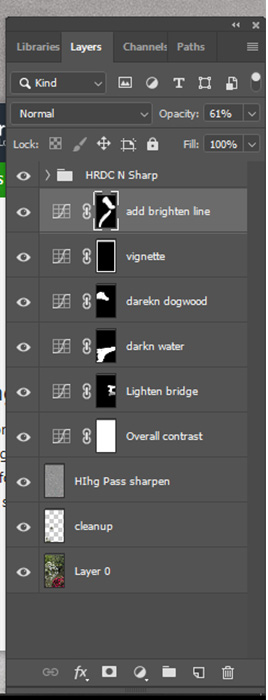
Masks
Masks allow you to target your edits to specific sections of your image.
If you look at the photo of my layers, you can see small black and white squares on several of the layers. These are the masks. Where the mask is white, your change will take effect in your photo. Where the mask is black, the change doesn’t affect your photo.
An easy way to remember this is “Black conceals, White reveals.”
Here’s a photo from the Herb Shop at the Central Market in Lancaster, Pennsylvania after my initial edits. The background shelves were too bright so distracted from the foreground when seemed too dark.
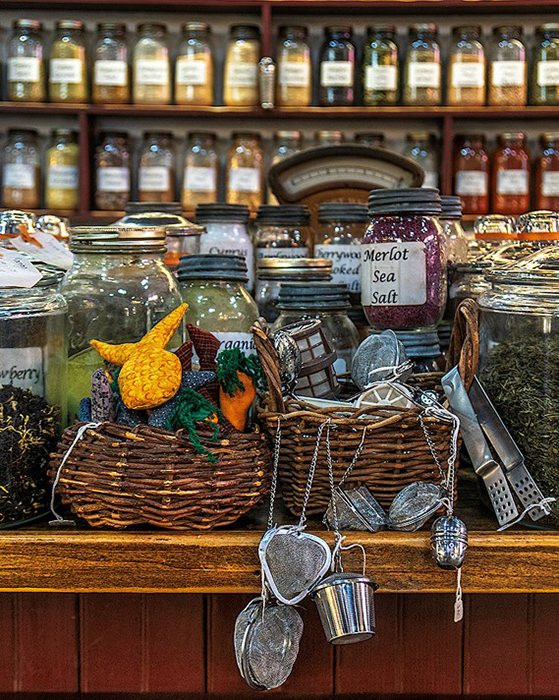
So I used a curves layer to darken the entire photograph by the amount I wanted to darken the background. I then applied a mask where the white area covers the shelves in the background that were too bright so they would be darkened. The rest of the photo isn’t darkened since it was protected by the black area of the mask. 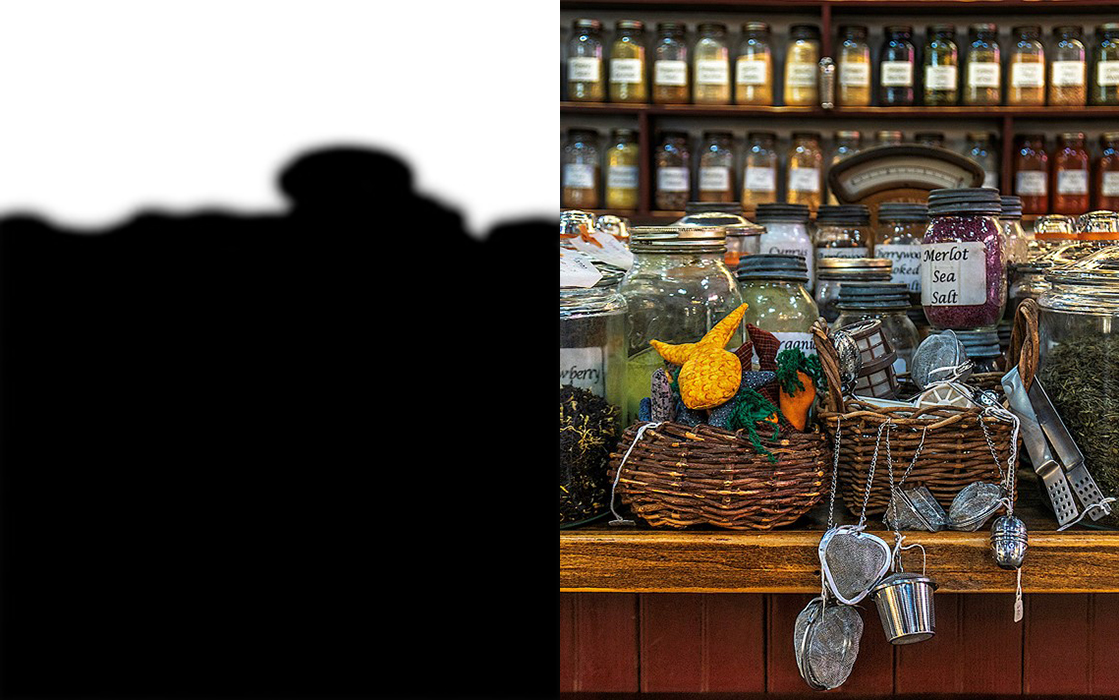
Then I used another curves layer to lighten the entire photograph by the amount I wanted to brighten the foreground. I then applied a mask where the white area covers the foreground of the photo that was too dark so this area would be lightened. The shelves in the background aren’t brightened in this new layer since the area was protected by the black area of the mask.
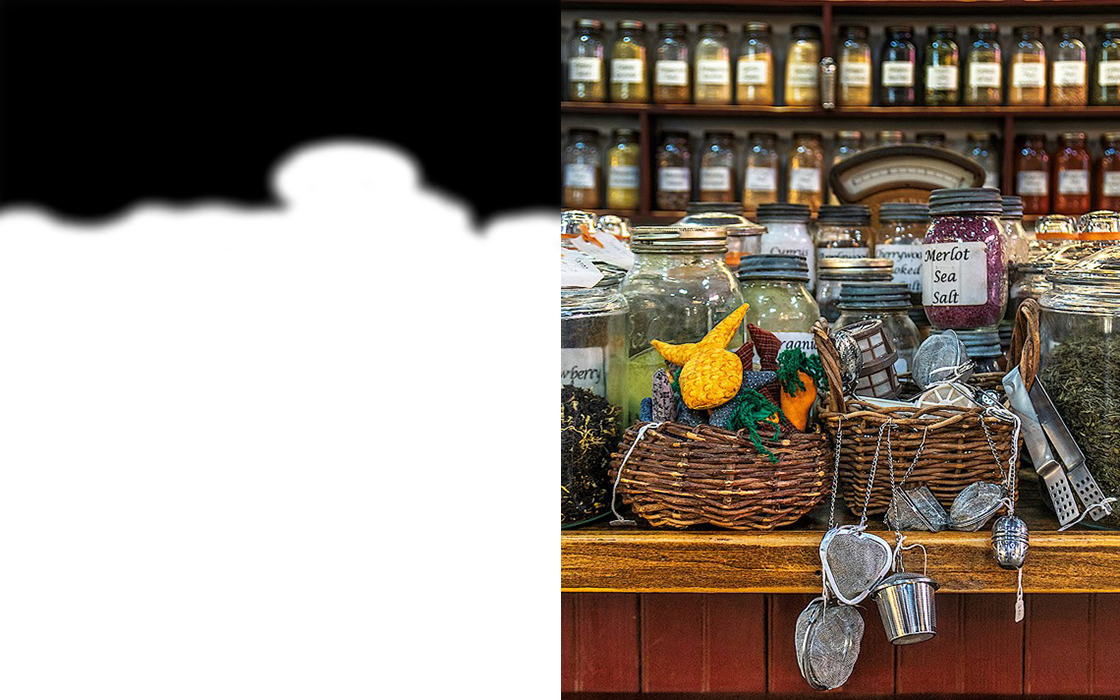
As you can see, using layers and masks in Photoshop allow you to make non-destructive edits to your photo, and control exactly what areas of your photo you want to be affect by a specific set of changes.
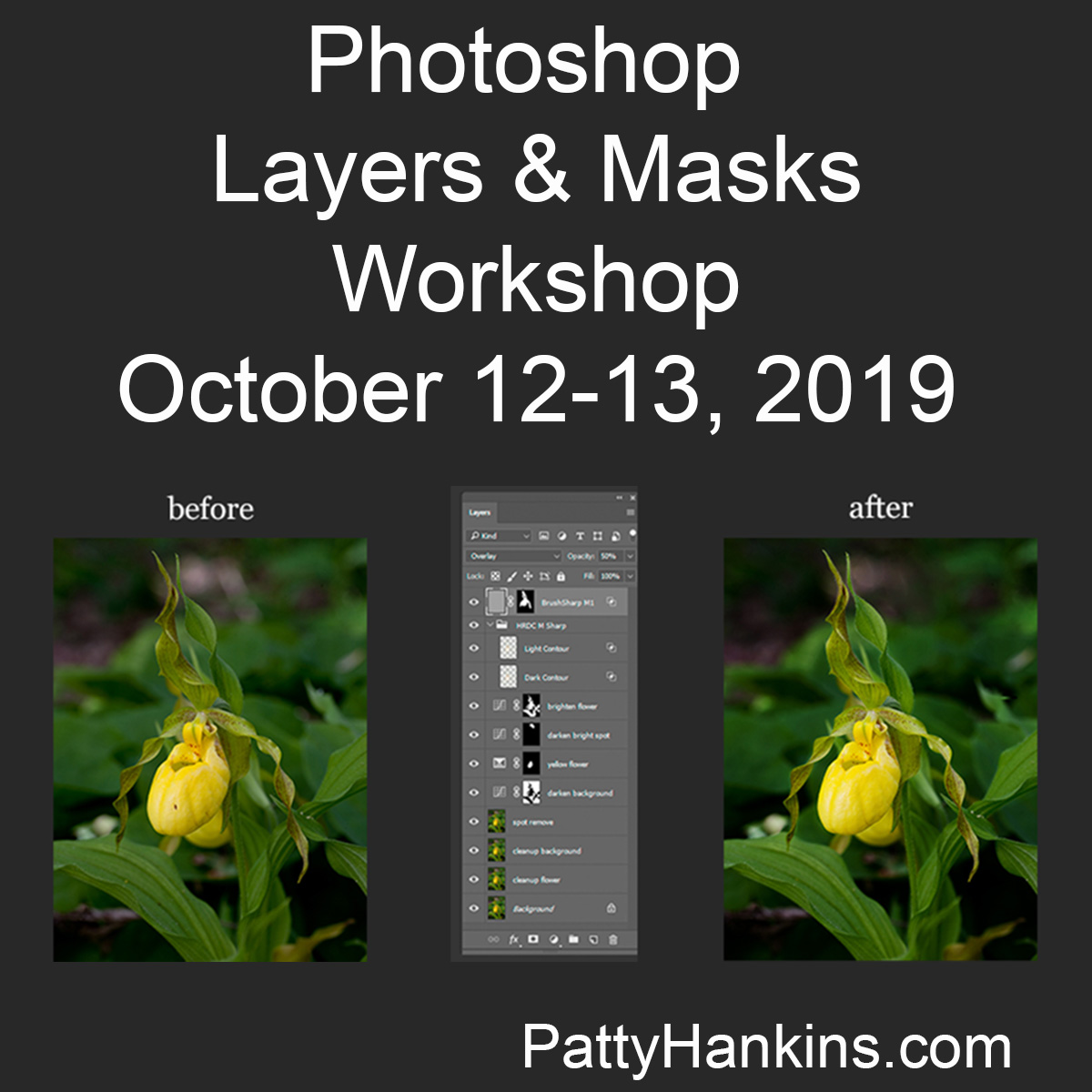
If you’d like to learn more about the power of Photoshop’s layers and masks, join me on October 12-13 for my Photoshop Layers and Masks Workshop. More information about the workshop is available at https://beautifulflowerpictures.com/store/photoshop-layers-masks-workshop-october-2019/
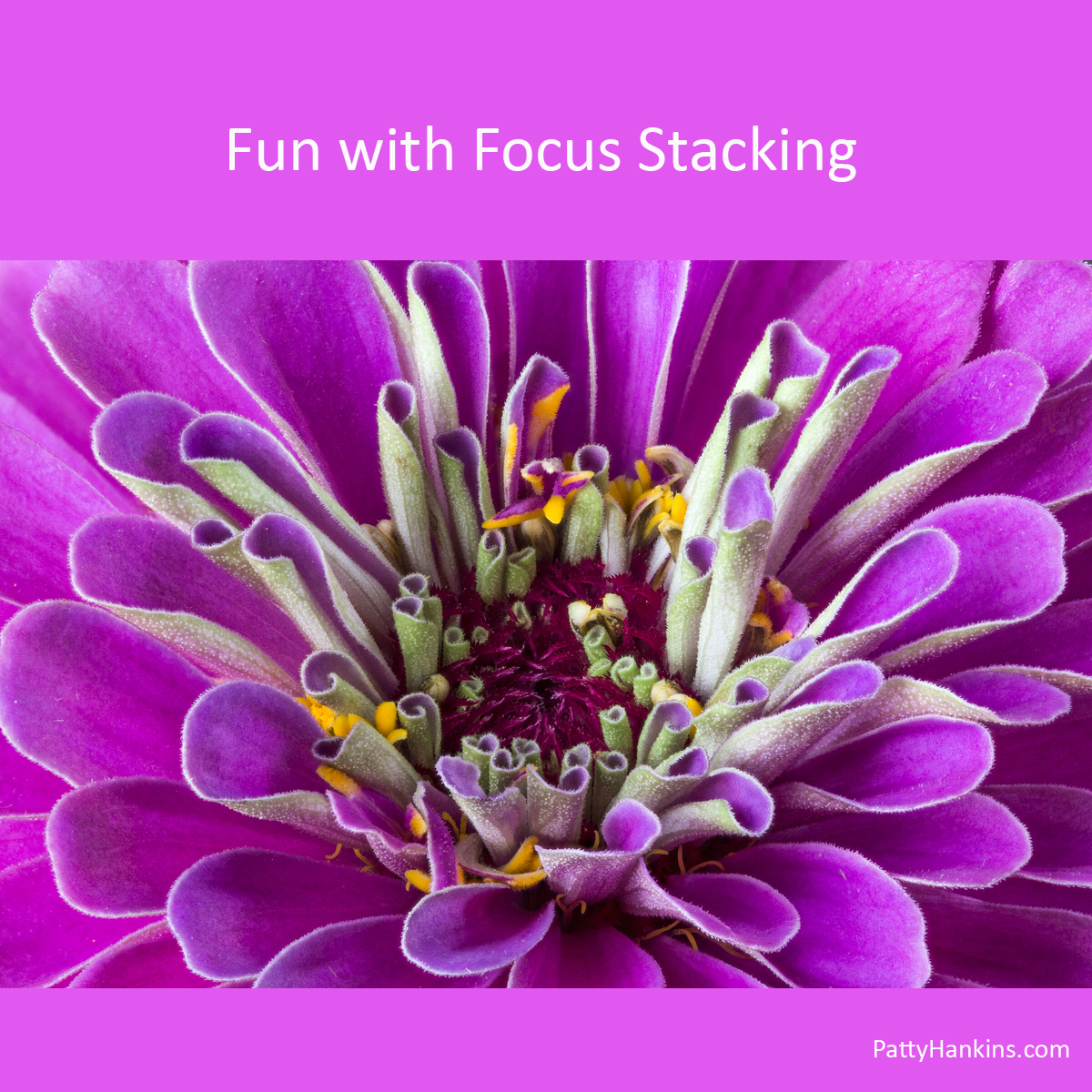
by hankinslawrenceimages | Jun 14, 2019 | Photo Tips, Software, Uncategorized
One of the questions I get asked fairly regularly is how do I get so much in focus (or so great a depth of field) in some of my flower photos that I take in my studio? People realize that since my camera is so close to my subject that it can be hard (if not impossible) to get everything the sharp focus.
The way I do it is to use a technique called focus stacking. Basically, I take multiple images of the same scene using a different focal point for each image, and then merge the images in software to create one image with a greater depth of field than I can get in a single capture. I used to use a program called Helicon Focus from Helicon Soft for focus stacking. These days I usually use Photoshop, with Helicon Focus as an alternate if I’m not happy with what I get in Photoshop.
Here are a few of my focus-stacked images with information on how many photographs I combined to create my final image
I combined 9 images to create this photograph of a purple poppy anemone.
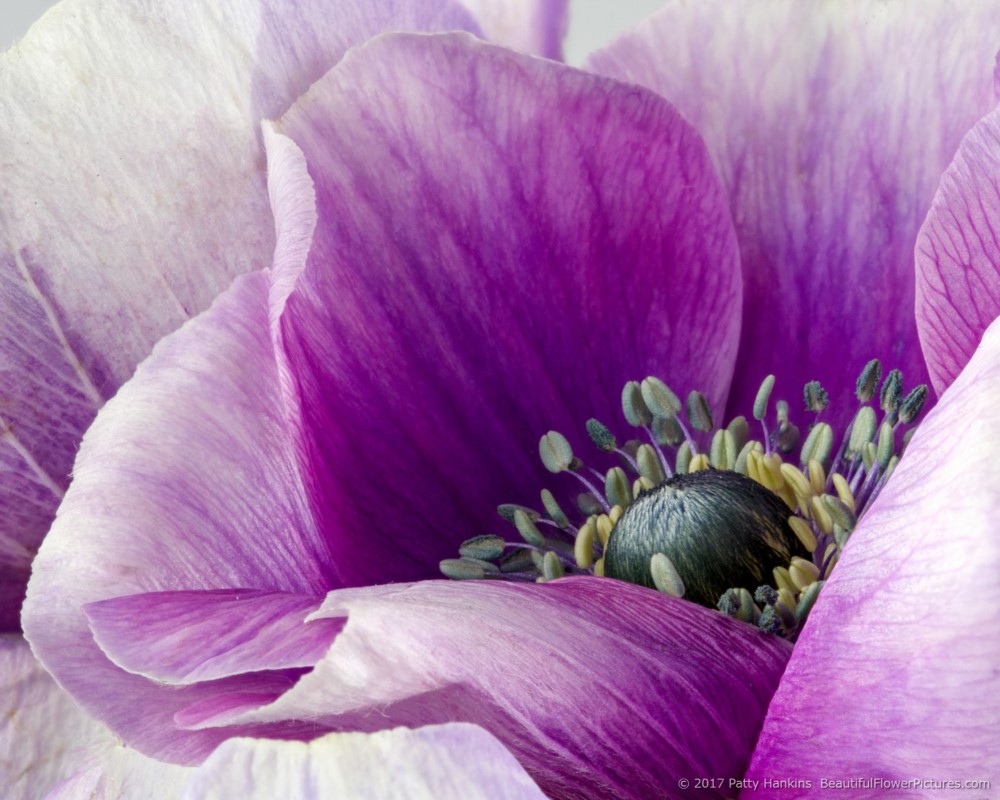
Purple Poppy Anemone © 2017 Patty Hankins
I combined 10 images to create this photograph of a pink and white tulip.
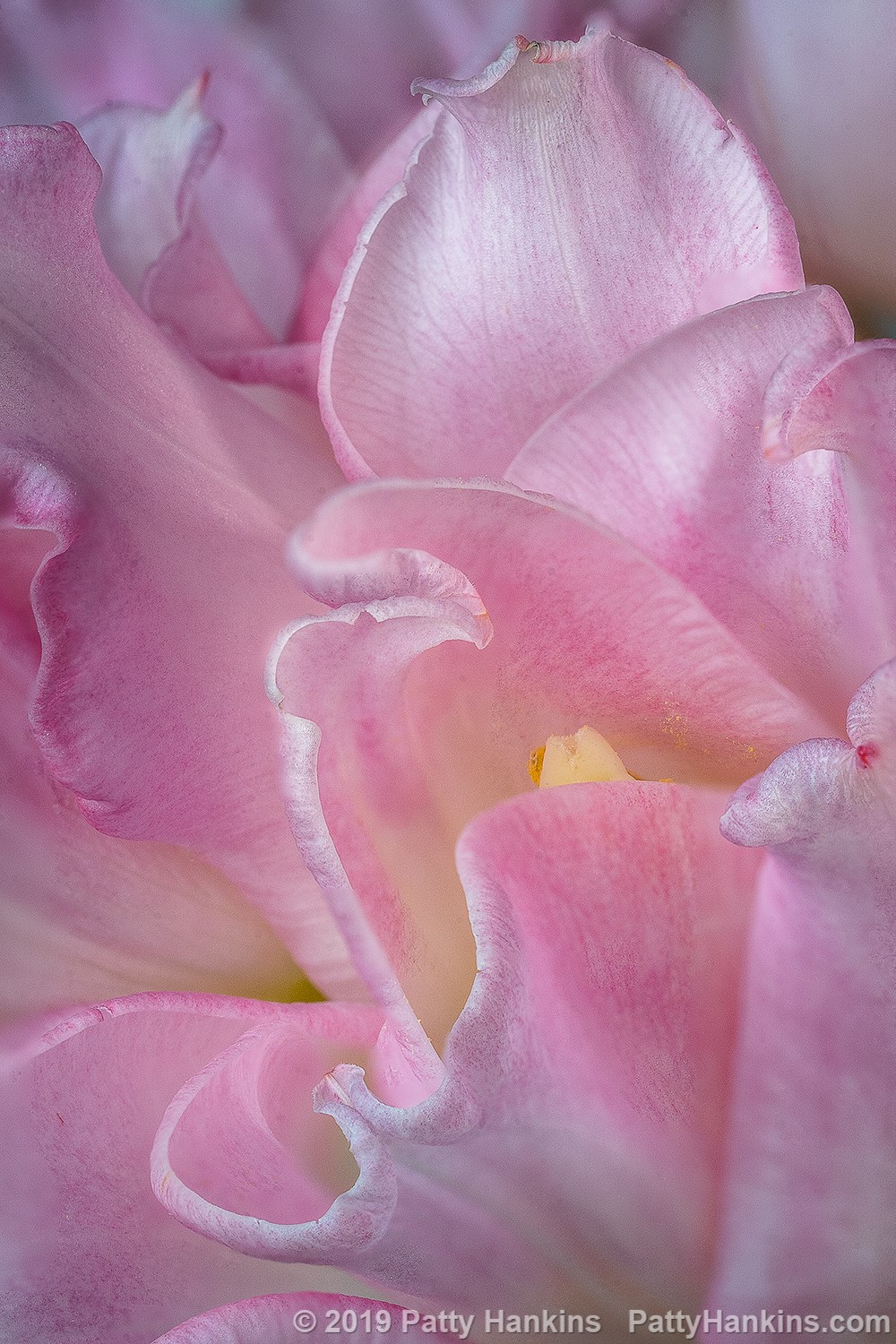
Pink & White Tulip Petals © 2019 Patty Hankins
I combined 10 images to create this photograph of a purple zinnia.

Purple Zinnia © 2017 Patty Hankins
I combined 11 images to create this photograph of a Peaches and Dreams dahlia.
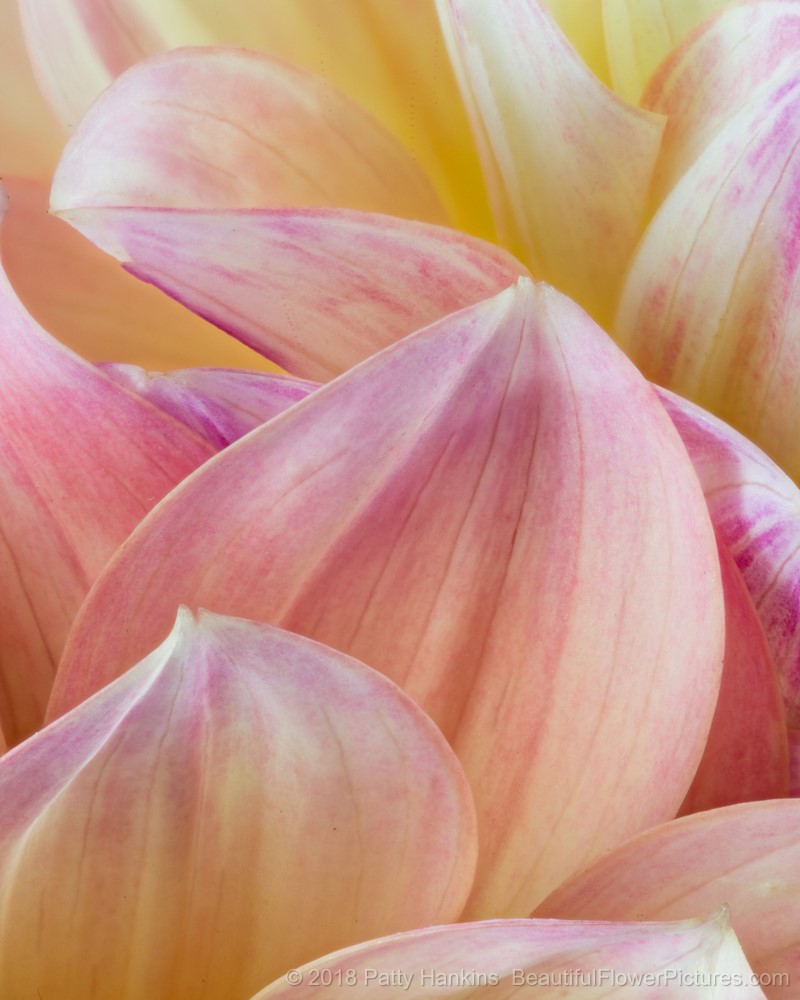
Petals of a Peaches & Dreams Dahlia © 2018 Patty Hankins
I combined 13 images to create this photograph of the Tulip Petal Wave
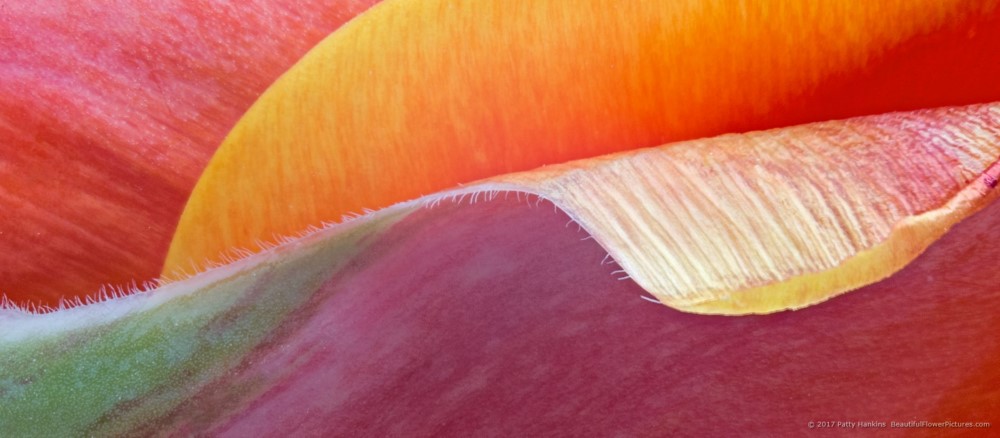
I combined 19 images to create this photograph of a Teddy Bear Gerbera Daisy
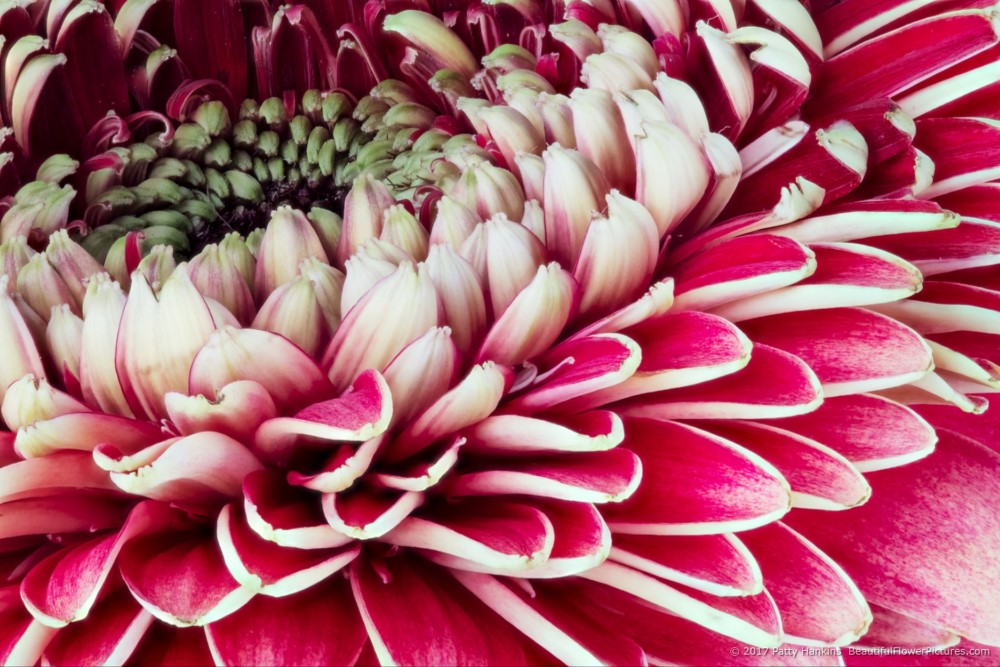
Teddy Bear Gerbera Daisy © 2017 Patty Hankins
And finally, I combined 25 images to create this photograph of Babe spray roses.
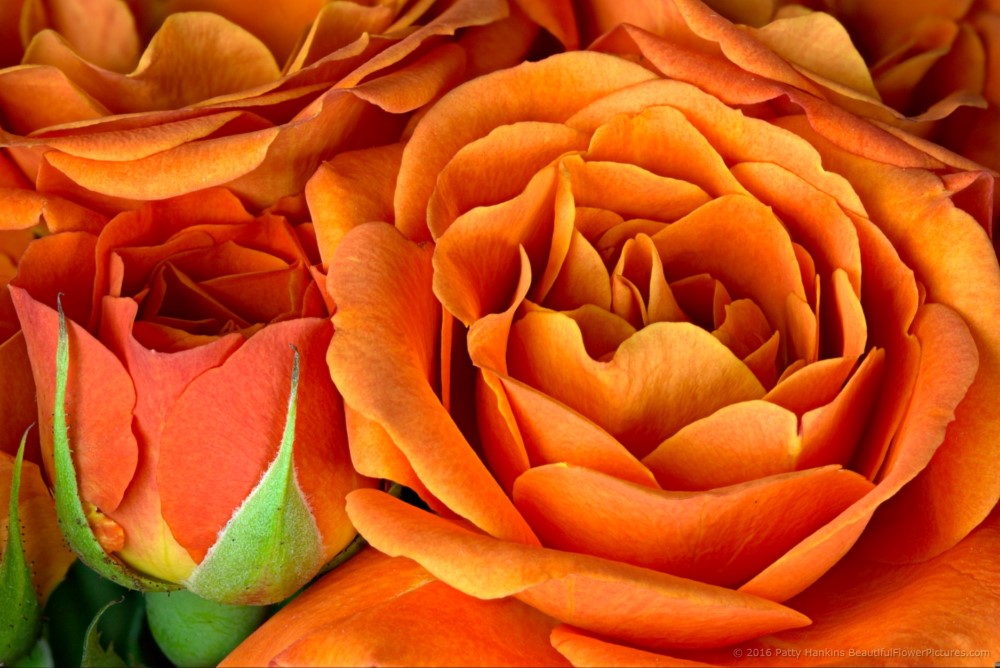
Babe Spray Roses © 2016 Patty Hankins
If you’d like to learn more about focus-stacking and how I take the different images that I then stack to create the final image, join me on July 27 for my Photographing Local Flowers in the Studio Workshop. We’ll spend some time talking about and working on focus stacking during the workshop. More information about the workshop including registration information is available at https://beautifulflowerpictures.com/store/local-flowers-workshop-july-2019/
If you’d like a sneak peek at how I create my focus-stacked images before the workshop, I’ve put some slides from a talk about focus stacking on my blog at http://www.beautifulflowerpictures.com/blog/focus-stacking-step-by-step-instructions/
by hankinslawrenceimages | Oct 26, 2018 | Photo Tips, Photoshop, Software
Well – that’s an impressive sounding title! What it really means is I’m going to share the step by step edits I made on my In the Shofuso Japanese Garden photograph.
On a visit to Shofuso Japanese Garden in Philadelphia I was captivated by the scene in front of me. I saw a line of water and the waterfall leading my eye to the temple in the trees. I saw azaleas and another small temple on the right framed by the water on the left. And finally, I saw the wonderful bright greens of spring.
Here’s what my camera captured.
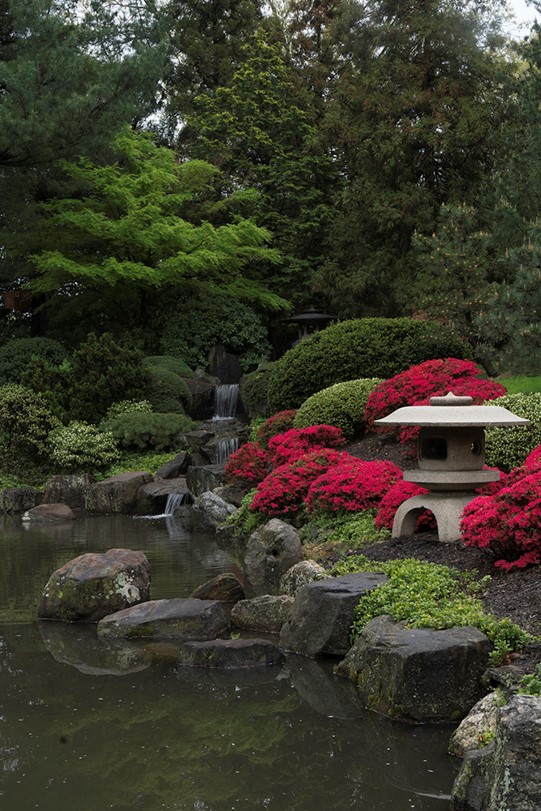
The first edits I made were done in Lightroom – where I cropped the photo to a square format and did some global adjustments (changes that affect the entire photograph) to brighten up the photo and increase the contrast just a bit.
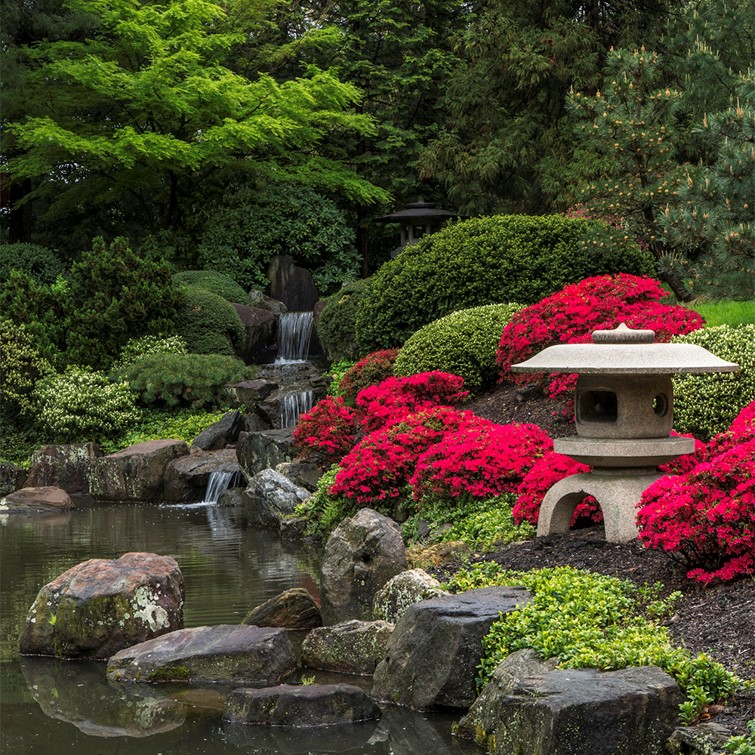
And then I headed into Photoshop to make a series of local adjustments (changes that affect just part of the photograph) tto draw your eye through the photograph so you saw what I saw that day in the garden. I used a series of layers and masks to make the local adjustments. I’m including screenshots of the masks so you can see just what part of the image I’m working on. In Photoshop, a mask allows you to choose where in your photo you want a change to apply. In white areas of the mask – the change is seen. In black areas of the mask – the change doesn’t affect the photograph.
My first change was to use a curves layer to brighten up the background. The background just too dark before I brightened it up
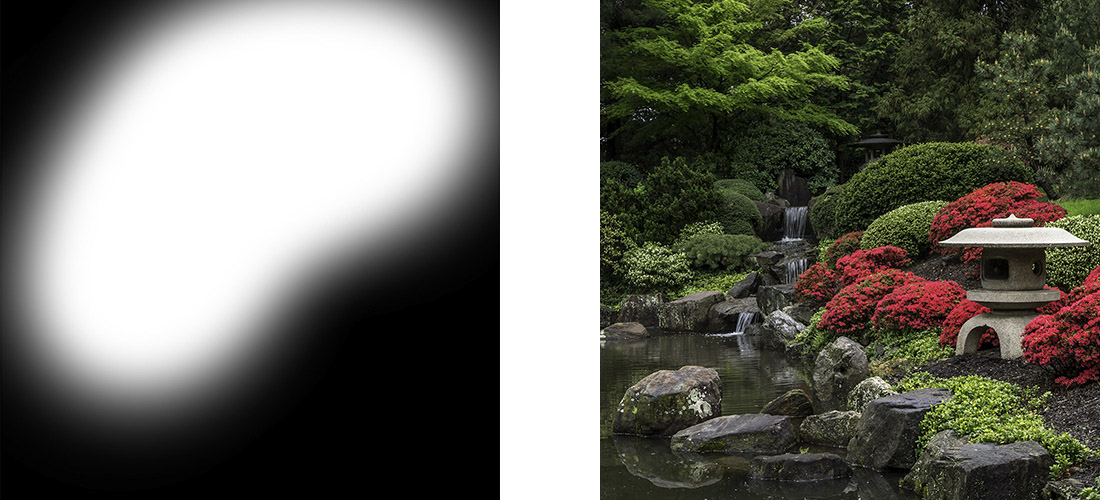
Next I used a curves layer to brighten the front temple. As I looked at the photo, the front temple felt like a dark heavy object in the photo and I wanted to lighten it up a bit.
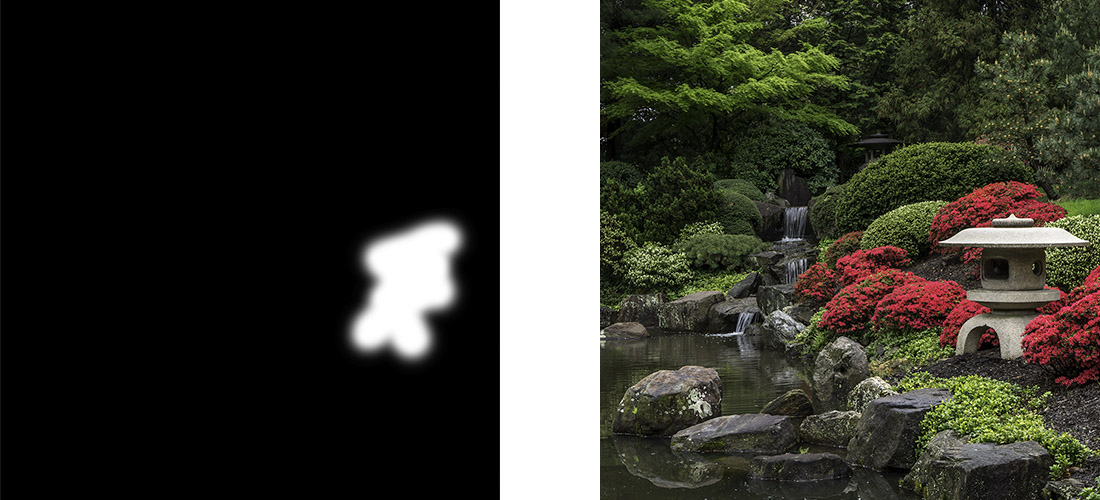
Followed by another curves layer to darken the top of the front temple. Once I made the changes to temple in the previous step, the top of the temple was too bright and drew my eye away from the water, so I darkened it down a bit.
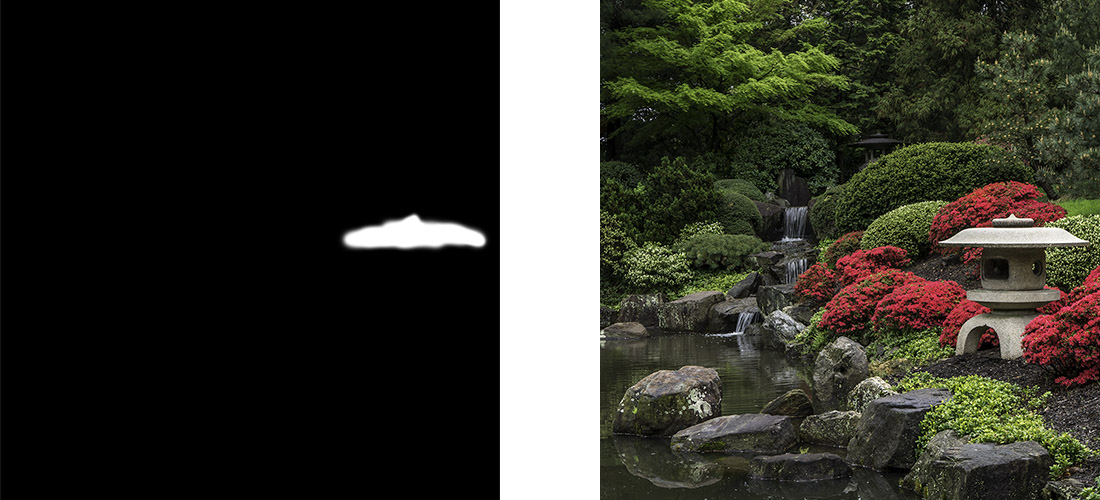
The next curves layer increased the contrast in the water. One of the things that really attracted me to the scene was reflection of the trees in the water, highlighting the beautiful greens of spring. By increasing the contrast in the water, I could bring out the reflection.
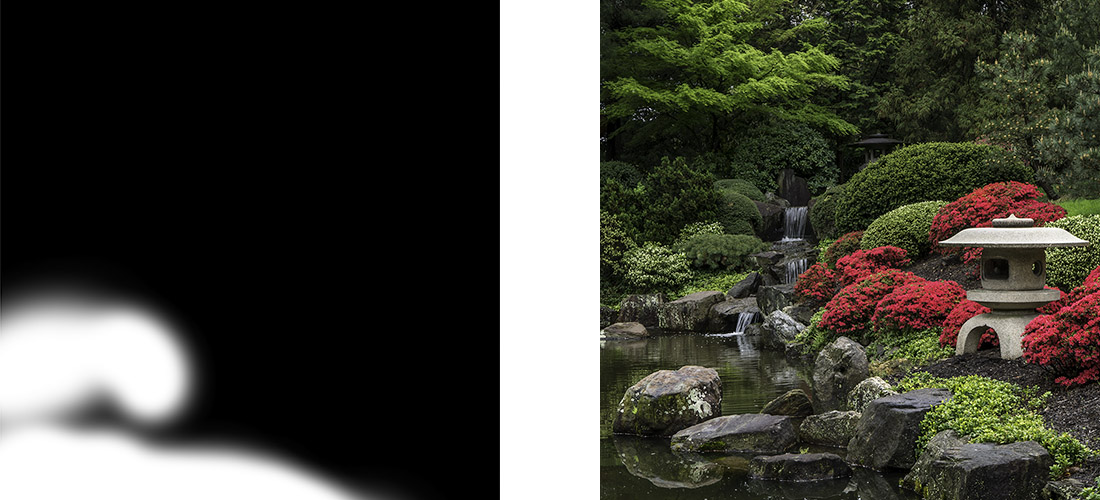
An then a curves layer to brighten the waterfall. As I took the photograph, I saw a line of water leading from the front of the scene, back through the reflections, up the waterfall to the back temple. By brightening up the waterfall, I can help you see the same line.
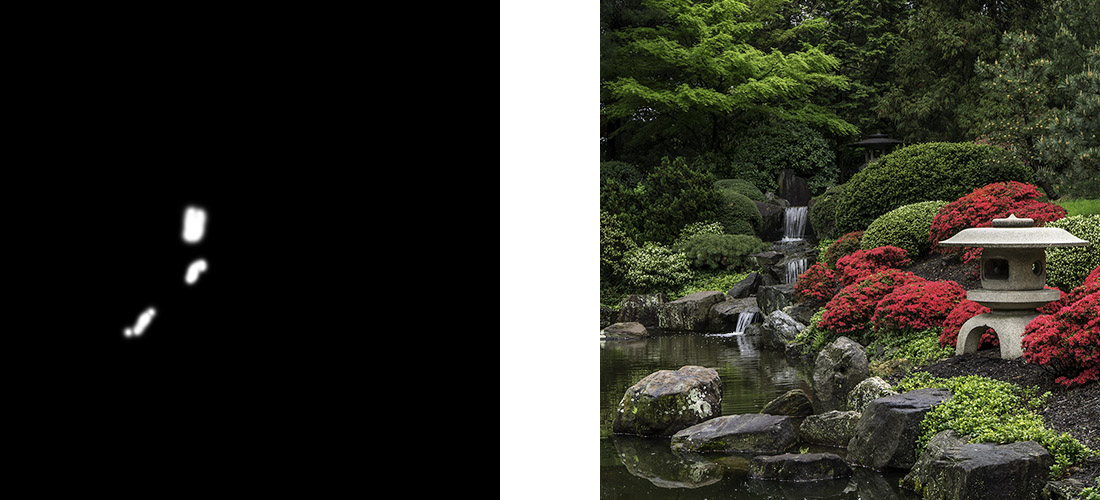
And another curves layer to brighten up the back temple. The leading line I saw ended at the temple in the back. In the photo, after I had brightened up the water, the temple was getting lost in a dark spot.
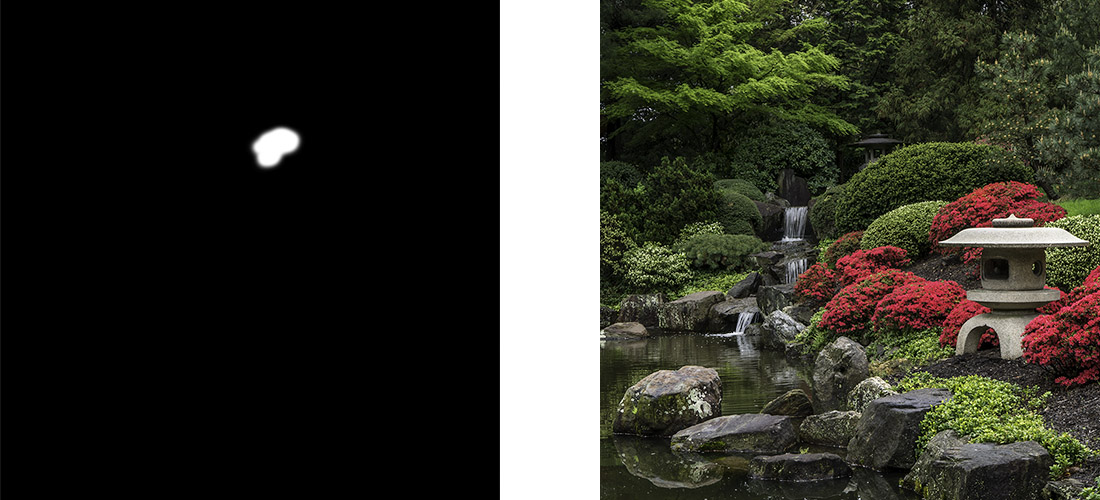
And yet another curves layer to brighten the reflections in the water. I love seeing that wonderful shade of yellow green in the spring, and I saw it reflected in the water at the garden. By brightening up parts of the reflection, I could share that same shade of yellow green with you.
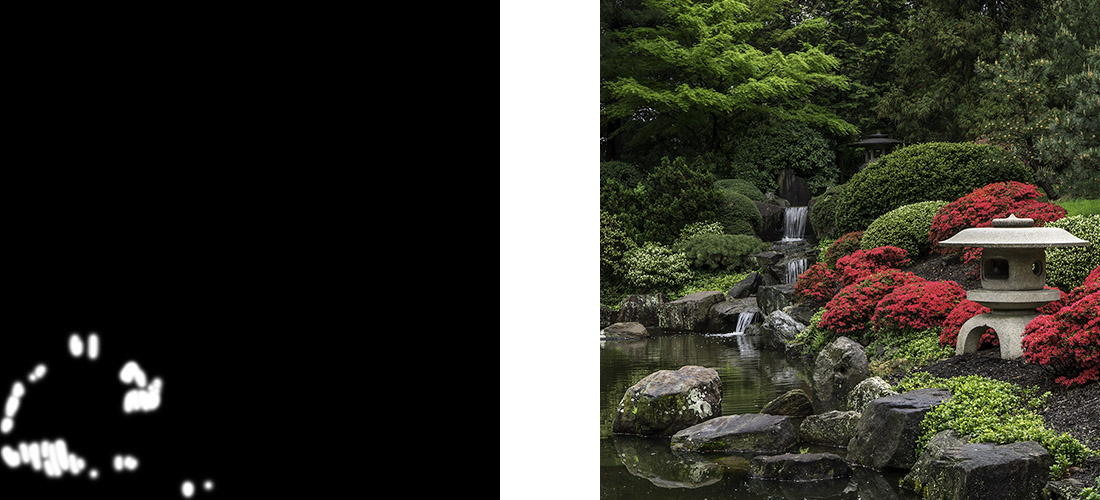
Followed by a hue/saturation layer to tone down the reds in the azaleas. With all the adjustments I’d made, they were just a little too bright. I didn’t need to use a mask on this step since the only reds in the photo are the azaleas so my change to the reds didn’t affect the rest of the photo. If there had been other reds in the photo that I didn’t want to tone down, I would have made a mask and just had the change affect the azaleas
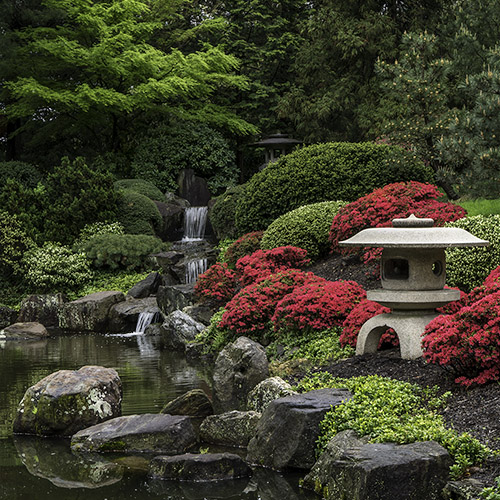
And finally a last curves layer to add a vignette to the photograph. I wanted to darken down the edges and corners to draw your eye into the center of the photograph.
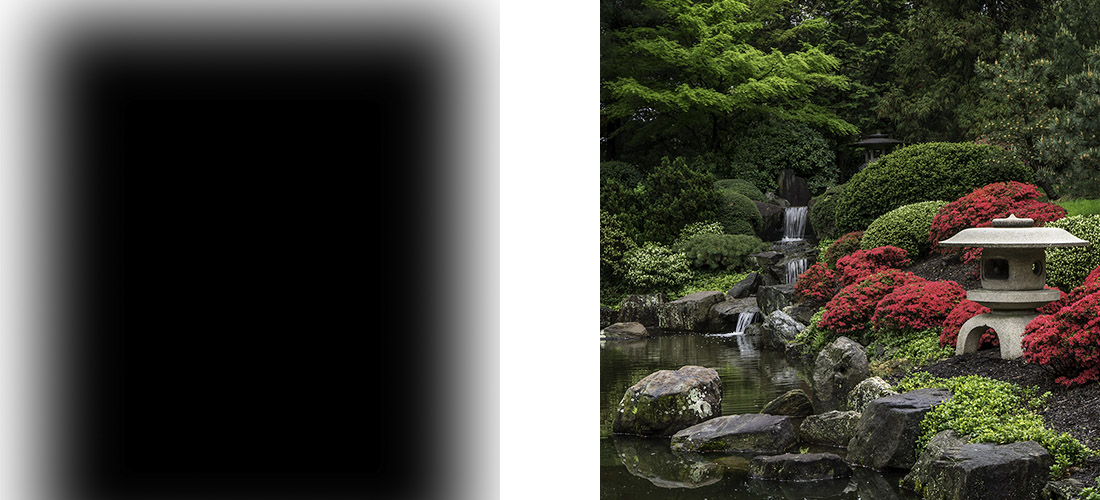
My last step was just to do a little sharpening on the photo. Since I photographing in RAW mode, no sharpening is applied when I capture my image, so I need to add a bit in at the end.
As you look at my initial capture and my final image, you can see how I used a series of small local adjustments to draw your eye into the photograph and follow the leading line from the bright reflection in the water, up the waterfall to the temple in the back. And also you can see a balance in the photo between the red azaleas and temple on the right side of the photo and the water and waterfall on the left.
My hope is that my final image allows you to see the same beautiful scene that I saw at the gardens that day.
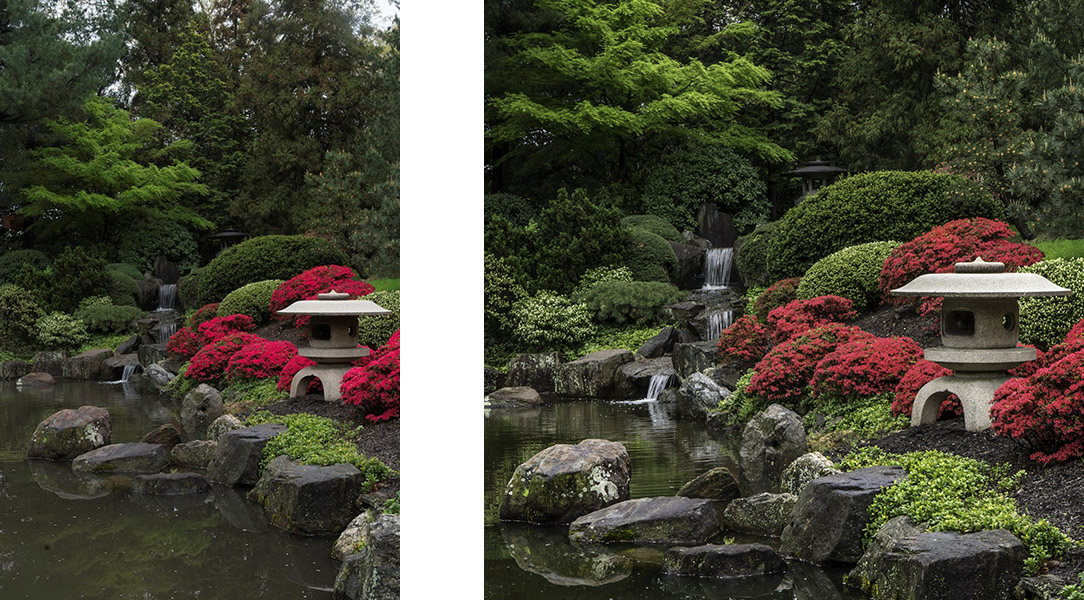
How I edited this photograph is one of the examples I share in a talk “The Power of Local Adjustments” that I have available for presentation to camera clubs and photography groups. If you belong to a camera club or other group that might be interested in having me speak about photography and photo editing, please drop me a note. I’d love to come speak to your group.
And if you love my photograph of the Shofuso Japanese Garden, it is available on my website at https://beautifulflowerpictures.com/store/shofuso-1/
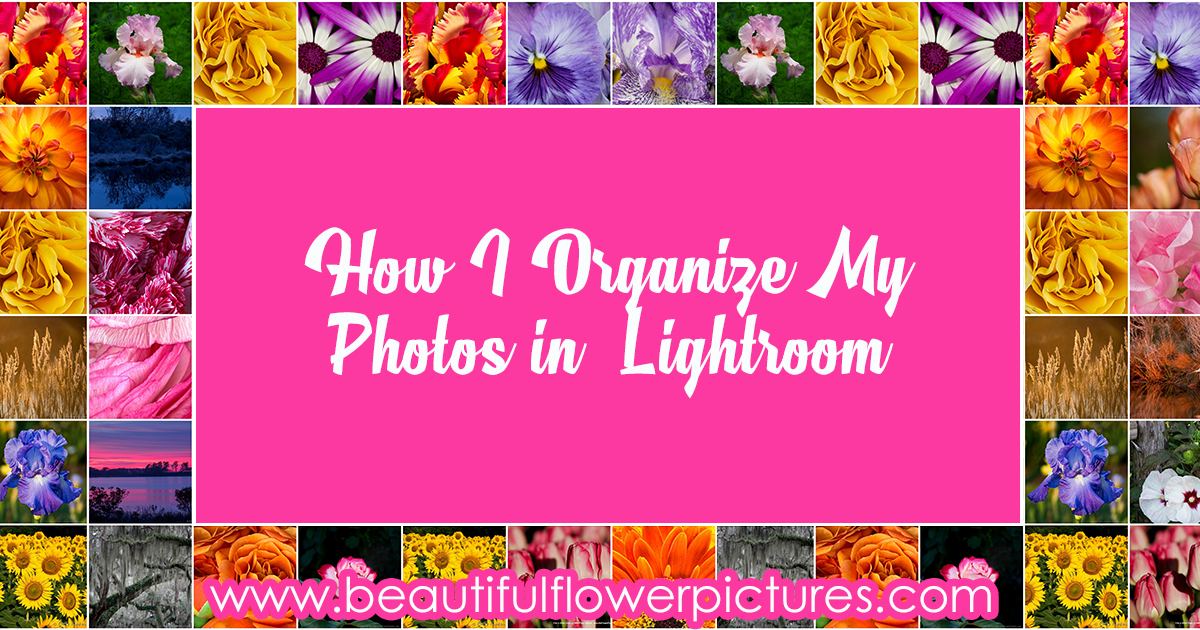
by hankinslawrenceimages | Sep 7, 2018 | Software
Just out of curiosity, how long does it take you to find a specific photo on your hard drive that you want to edit? I know it can be a challenge. I’ve got over 200,000 digital photos on my various hard drives and it used to drive me crazy when I wanted to go back and find a photo and I’d see a directory full of unedited photos with file names that were a combination of letters and numbers assigned to them by my camera.
When Adobe first released Lightroom in 2007, they included something called the Library module for photographers to use to organize our files. Once I started using the Library module, and taking time to organize my files as I added them to Lightroom, all of a sudden, I could usually find what I wanted in just a few minutes
And now that I’ve been using Lightroom for over a decade, and have continued to organize my photos as I add them to Lightroom – I can find any one of the 90,000+ photos that are in my catalog in under a minute. As for all the photos that I still haven’t added to Lightroom – I’m working on adding them. Because until I do, I can’t find a specific photo without spending an awful lot of time opening directories and searching for a photo.
I thought I’d share how I organize my photos in Lightroom using the Library Module with you today.
The best way I’ve found to describe the Library Module is to think of it as a giant card catalog – where the photos are the individual books in the library that you can find using the card catalog. And since I’m old enough to have used card catalogs at libraries all the way through getting my first master’s degree – the system makes perfect sense to me. Just like you can find a specific book in a card catalog by title, author and multiple subjects – I can find photos in my Lightroom library by date and multiple subjects.
As an example – here’s a photo I took of a Jason Hibiscus at Longwood Gardens on December 15, 2008.
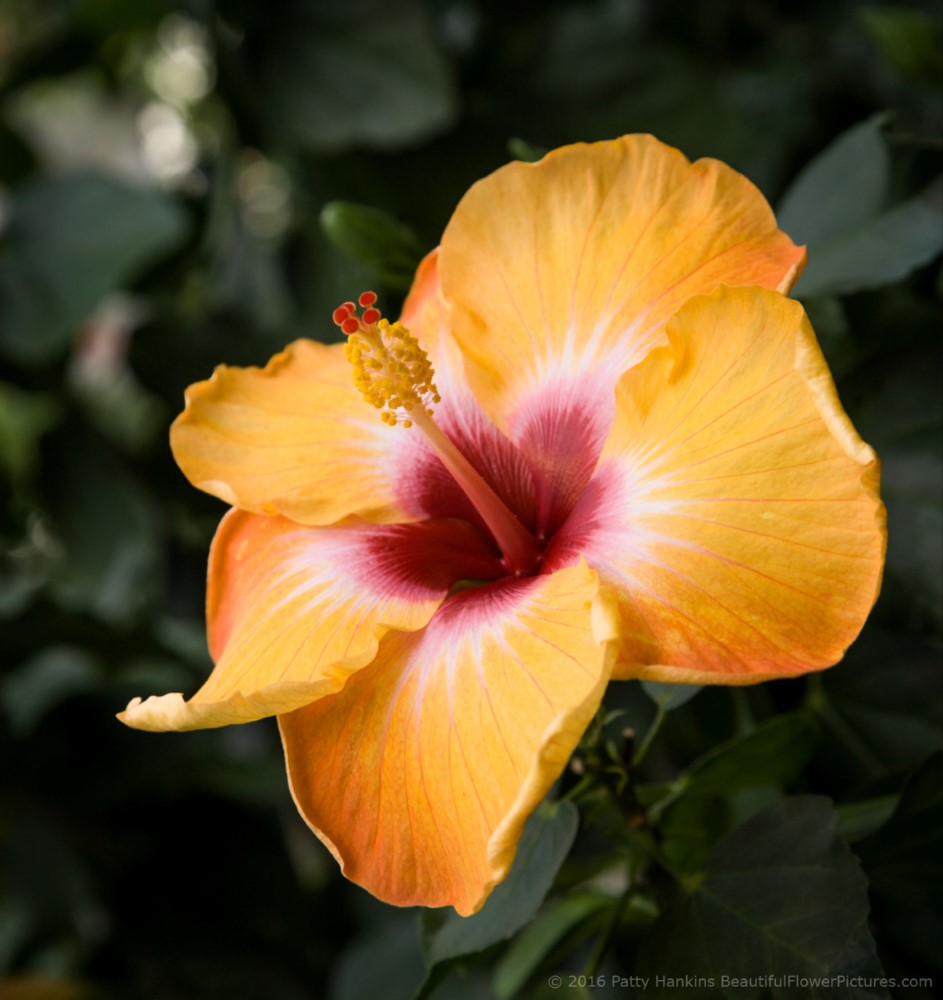
The first place I can look for the photo is in the Folders section of the Lightroom Library Module. This is simply an alphabetical list of the folders with files that I have imported into Lightroom. I organize the folders on my hard drive by date, with descriptive info in the folder name. So since this photo was taken in December 2008 at Longwood Gardens – it can be found in the folder plh_121508_longwood_flowers in the 12 subfolder of the 2008 folder. And you can see it here in the Folders section in Lightroom.
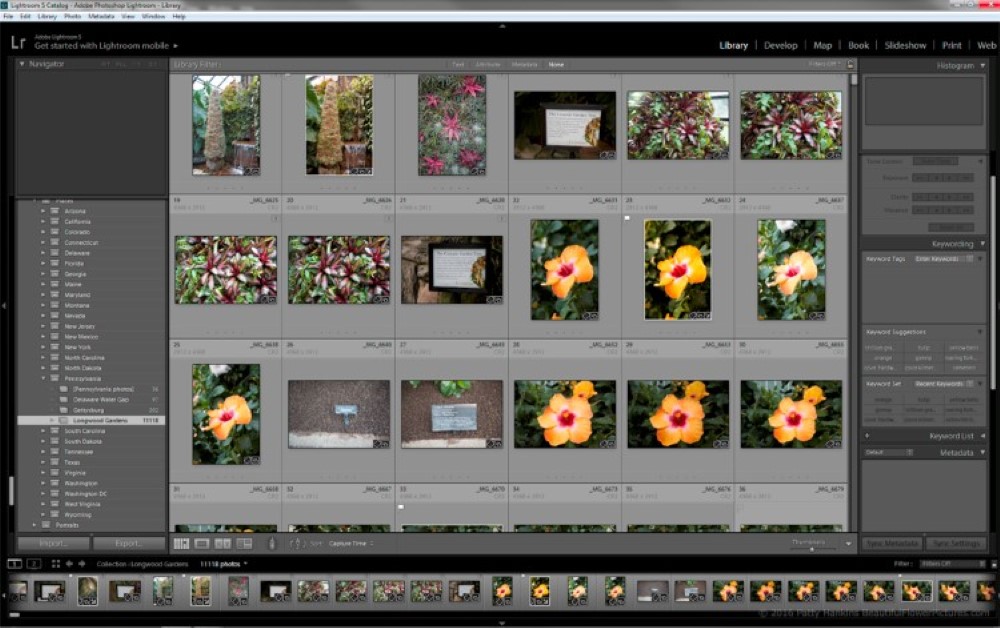
To be able to find the file easily this way – I’d need to remember the exact date I took the photo on. And in most cases I have no clue what the date I took a photo on several years ago. Fortunately, Lightroom’s Library Module also has collections that function as the subject categories in a card catalog. And you can file a photo under as many subjects (or in as many collections) as you want.
My collection sets (groups of collections) are based on broad categories of things I photograph. So I have collections sets for flowers, state and national parks, places, models photographed in the studio, flowers photographed in a studio, etc. Here’s what my top level Collection Sets list looks like.
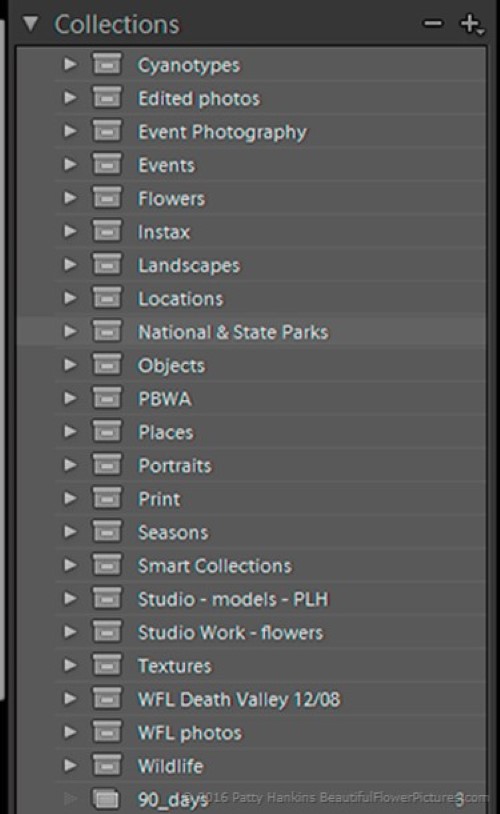
In my Collection Sets I have two obvious places to look for the file for the Jason Hibiscus. The first is in the Flowers Category Set – and the second is in the Places Category Set.
Within the Flowers Collection Set, I have collections for each type of flowers – lilies, roses, orchids, etc – that I’ve photographed. The Flowers Collection Set shows all the photos I’ve put in any of the flower specific collections.
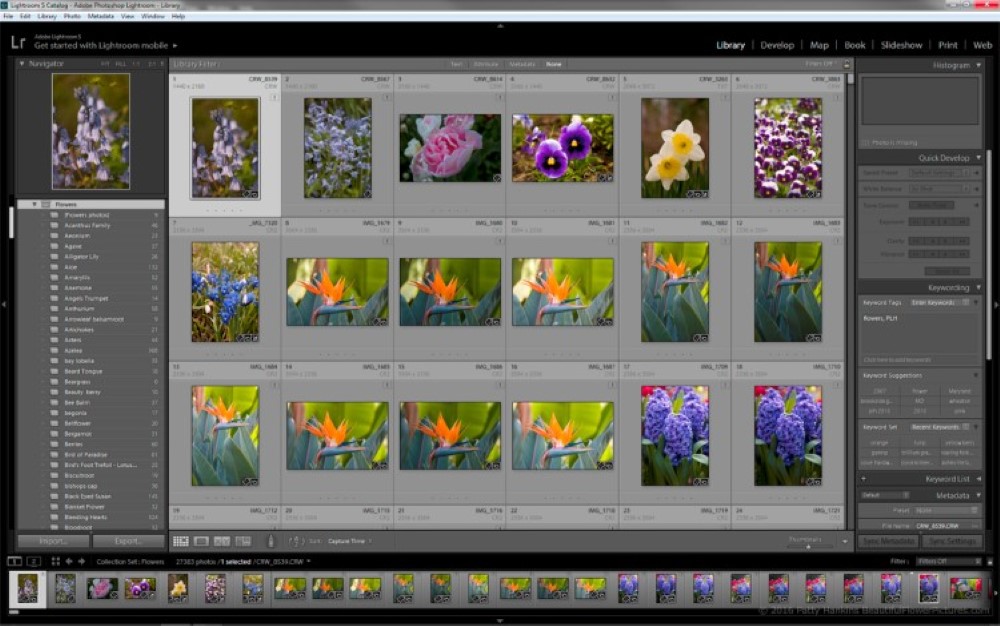
Within the Flowers Collection Set is a Collection called Hibiscus – which is where I can find all of my hibiscus photos, including the Jason Hibiscus I photographed in December 2008. You can see the original uncropped, unedited version of the photo highlighted as the first photo in the set.
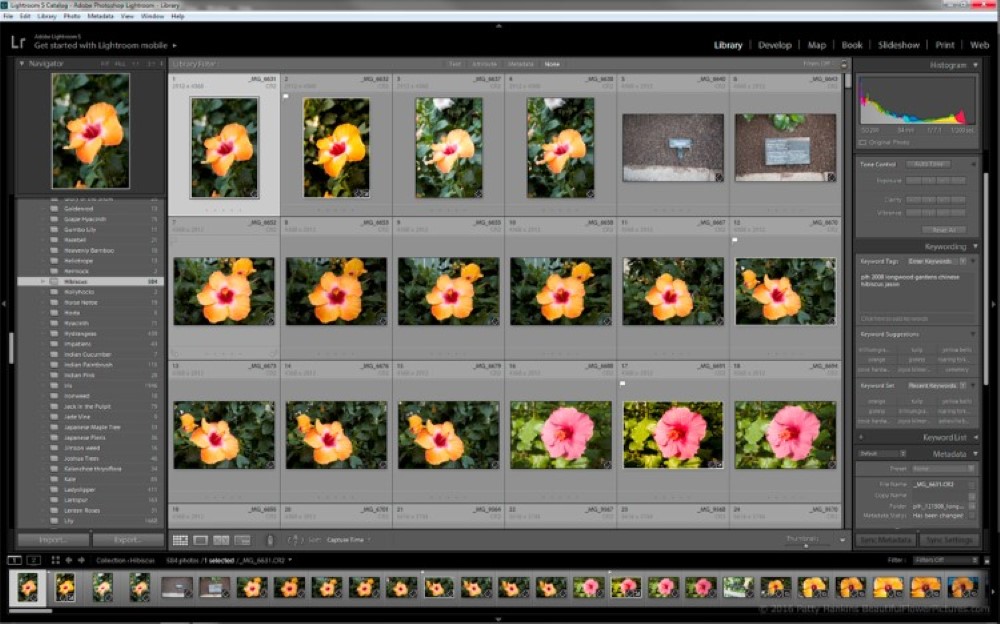
Of if for some reason I can’t remember what type of flower the photo I’m looking for is – I can always look for it by location. In the places Collection Set – there are Collection Sets for all the states I’ve photographed in. And within each of the state folders, are folders for specific locations. Since I knew the photo was taken at Longwood Gardens in Pennsylvania – I can look in the Places Collection Set in the Pennsylvania Collection Set to find all the places I’ve photographed in Pennsylvania.
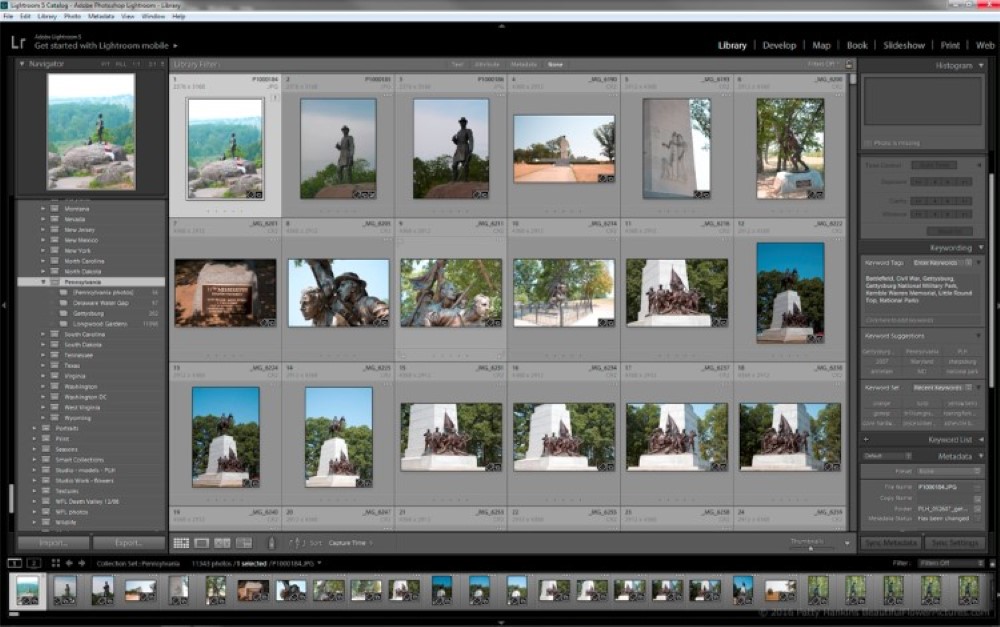
I could find the Jason Hibiscus photo by scrolling through all my photos taken in Pennsylvania to find the right one – or I can look in the Longwood Gardens Collection to just see all the photos I’ve taken at Longwood Gardens.

What I love about the Collections in Lightroom’s Library module is that I can create an organizational structure that works for me and the types of things I tend to photograph. And the structure i create only needs to make sense to me. Which means you too can create a organizational system in Lightroom’s Library Module that works for your needs.
In addition to folders and collections, Lightroom allows you to use keywords to describe photos as you add them to your catalog. Again, you can use terms that make sense to you, I tend to use the type of flower, the name of the flower, where I photographed, etc.
When I searched for Jason – Lightroom quickly showed my the 97 photos with that keyword so all I had to do was scroll through to find the exact photo I wanted.
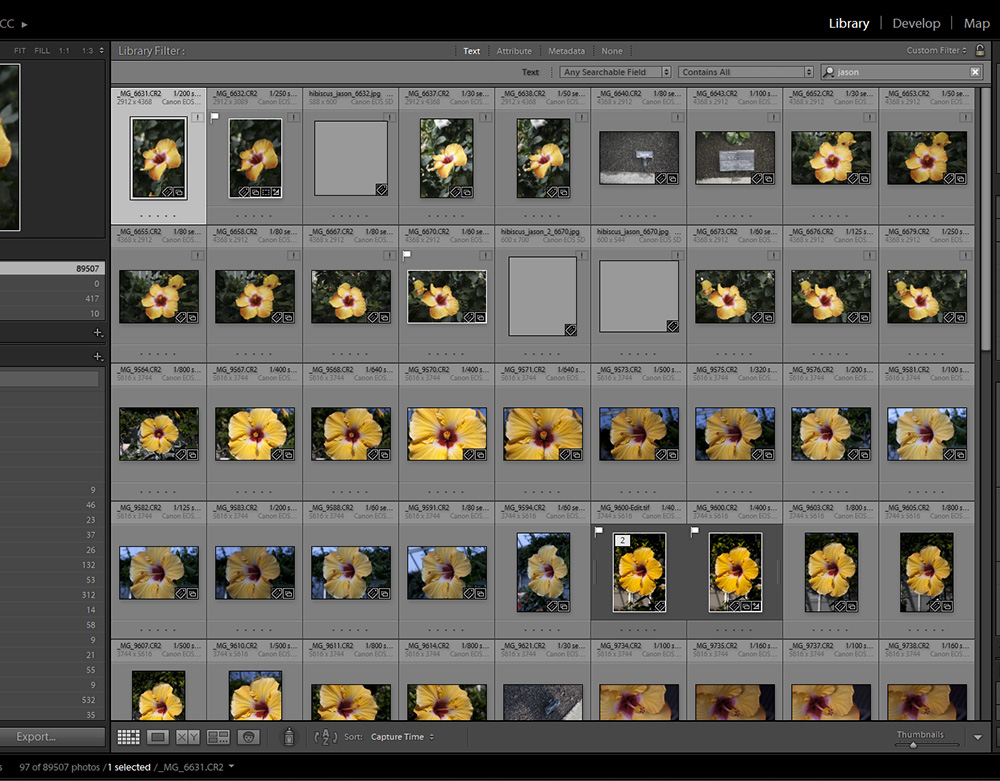
The keyword search gives me one more way to find my photos in Lightroom.
If you’d like to learn more about organizing your photos using Lightroom’s Library Module, join me for me Introduction to Lightroom workshop on September 29-30 at my home in Bethesda. We’ll spend the weekend working with Lightroom’s Library and Develop modules.
More information about the workshop including registration details are at https://beautifulflowerpictures.com/introduction-to-lightroom-2/
If you have any questions about the workshop or how I organize my photos in Lightroom, drop me a note and I’ll try to help
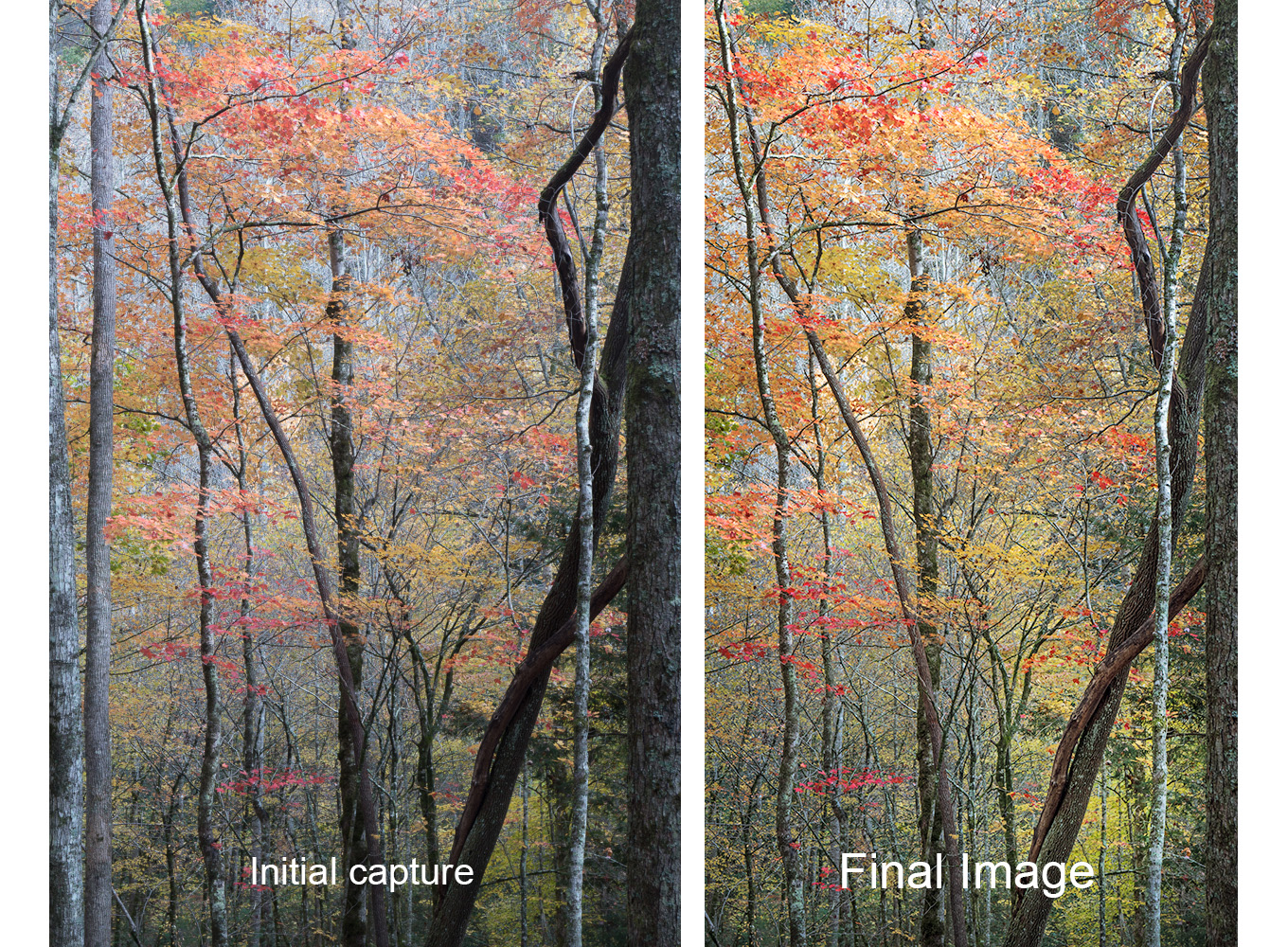
by hankinslawrenceimages | Mar 23, 2018 | Photoshop, Software, Workshops
I often get asked how much and what do I do when I edit my photos. My answer is always – I do what I need to in Lightroom and Photoshop to show you in my final photo what I saw and felt.
Today, I thought I’d take you through my editing process and show you how I’ve edited one of my fall color photos from last fall’s trip to the Smokies from start to finish.
I was photographing fall color along River Road in the Great Smoky Mountains National Park. All week, the lighting conditions had been a little challenging – clouds, then bright sun, then lots of contrast, then less contrast – so I just set my camera on auto bracket to capture three exposures of each image in case I needed to merge multiple images to properly capture the scene.
What caught my eye in this scene was the light coming down through the leaves highlighting the beautiful reds, oranges and yellows.
So I took my camera out of my backpack and set up my tripod. I captured three images – at ISO 100, f 11 – one photo at the normal exposure, one photo a full stop down and one photo a full stop up.
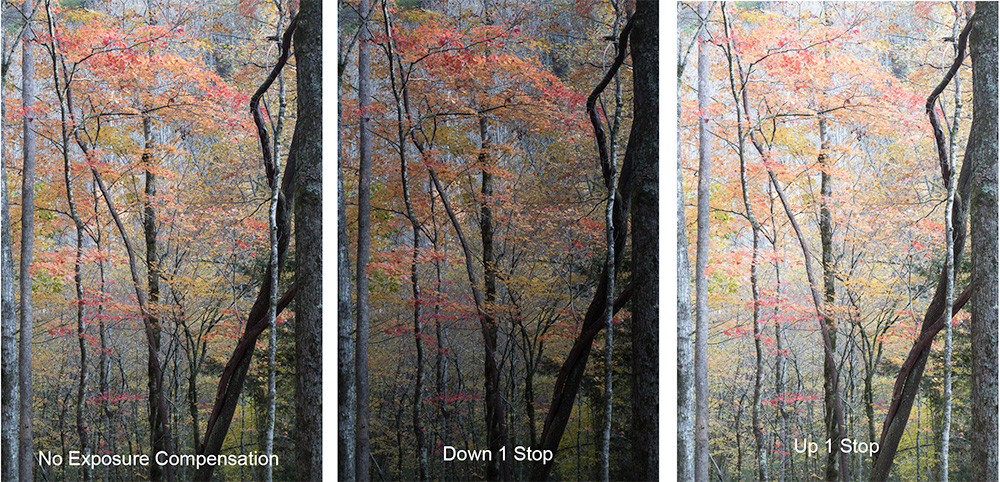
Looking at the three images, I decided to merge them using Lightroom’s HDR merge function to give me one image with a greater dynamic range than any of the three individual photos.
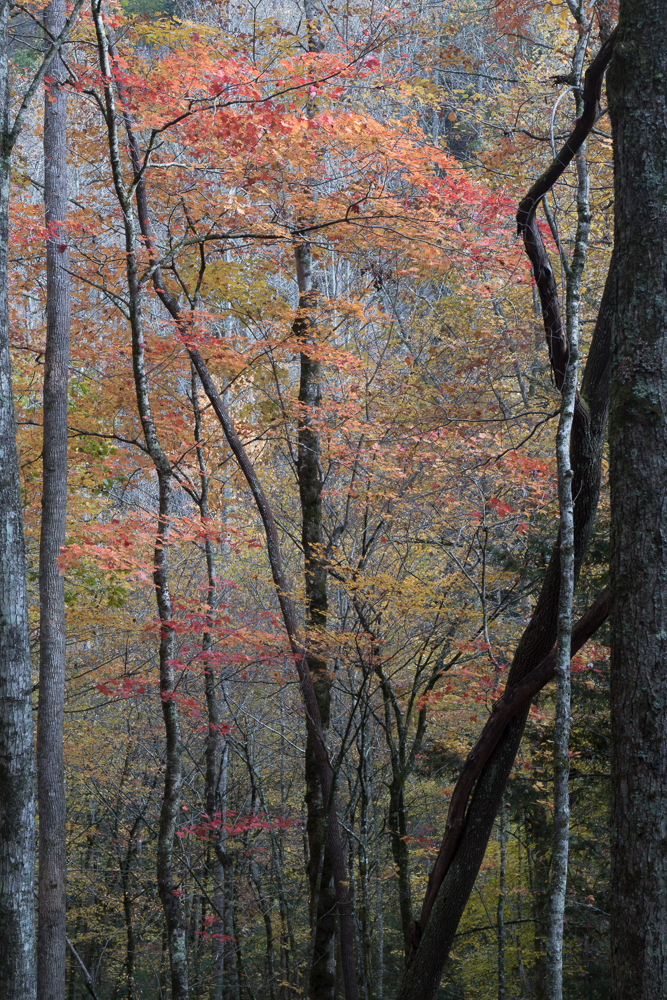
Then in Lightroom I did some initial edits – cropped the photo to a 16X9 aspect ratio and made some changes in the Basic Panel of the Develop module adjusting Highlights, Shadows, Blacks, Whites and Clarity (mid-tone contrast). My goal was to have a well-exposed file to take into Photoshop.
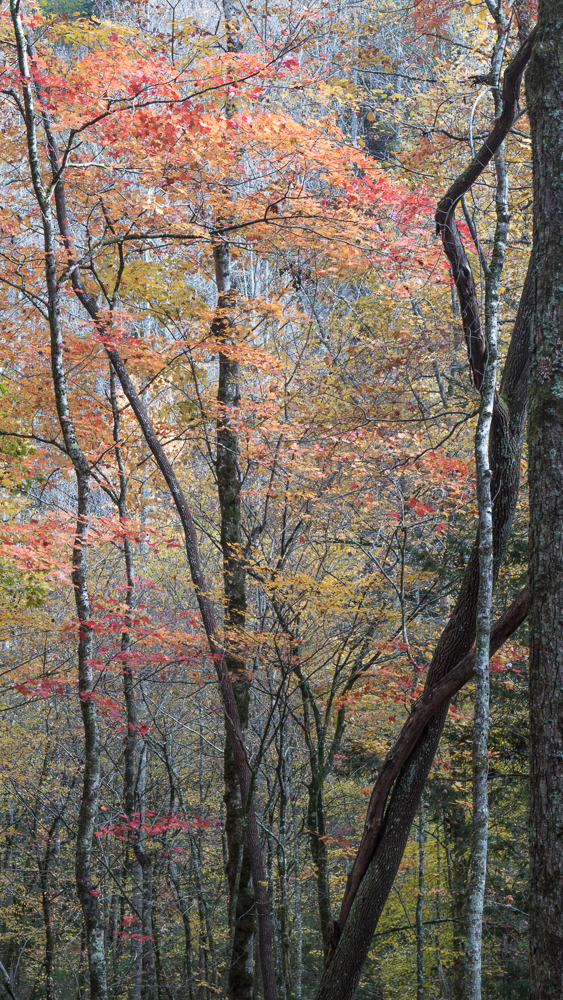
Once in Photoshop, I made my next set up of edits. I opened up the shadows on the lower third and right hand side of the photo to lighten the trees and woods in the foreground. I then took some blues out of the entire photo to warm it up – photo felt cool to me and I wanted to share the warm colors I saw in the woods. And then finally I added a little bit of saturation to the red and yellows leaves to make them stand out a bit more.
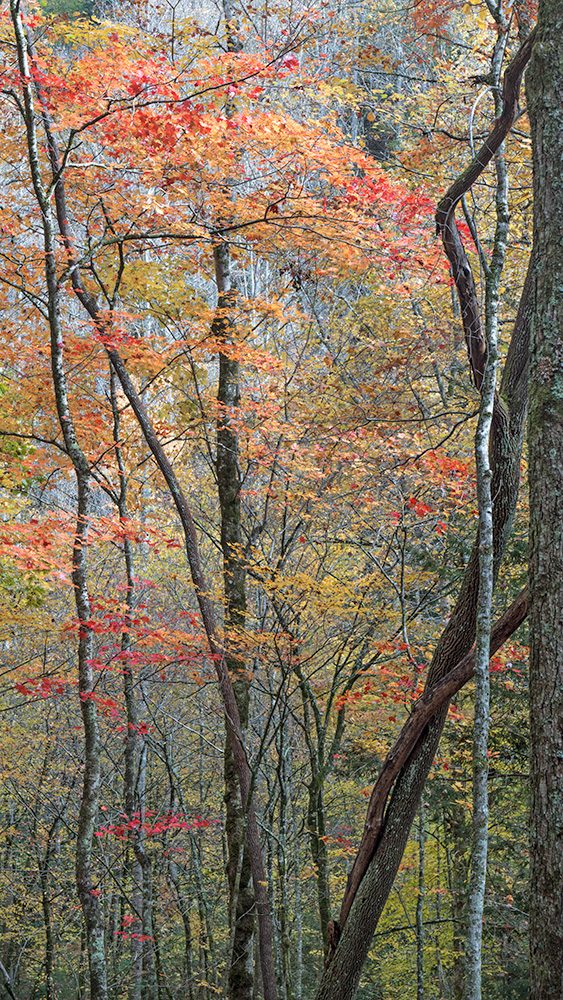
Now that I’d completed my first set of edits, I printed a copy and Bill and I took a look at it. I’ve found it really helps to have someone else review my prints as I’m working on a photo. Bill often sees things that I don’t see – since I took the photo and know what I want it to look like – whereas he is looking at it with fresh eyes.
As Bill and I looked at the photo, we realized that it looked flat and didn’t reflect the light coming through the trees that had caught my eye in the woods. So I brightened the leaves and woods from the upper left corner of the photo down towards the lower right corner to draw your eye into the photo and into the woods. I also brightened up the white and gray bark on the narrow tree along the left side of the photo to bring your eye that direction. Finally, I added a vignette to the photo to draw your eyes away from the edges and towards the center of the image.
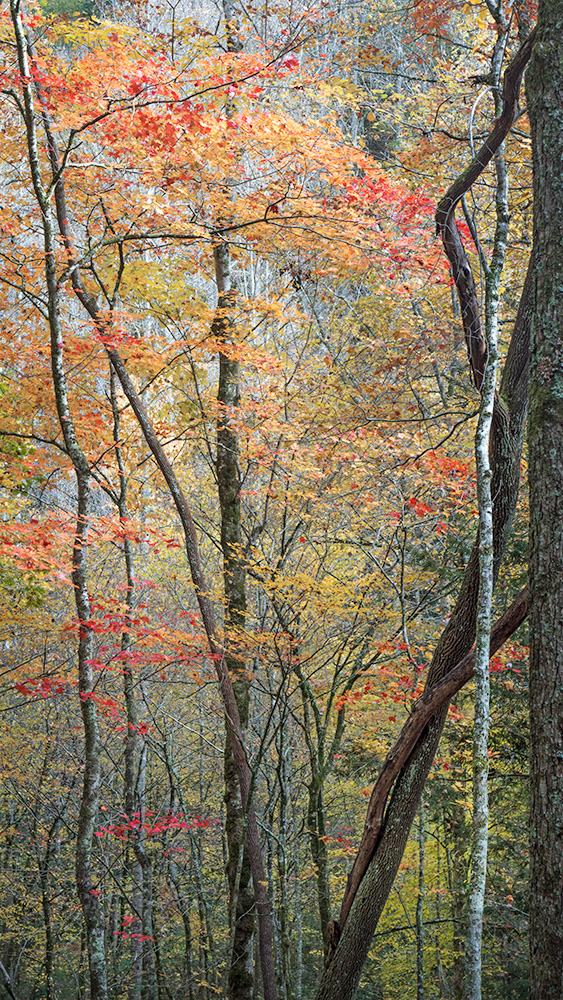
So I ran another print and thought the photo looked really good. And then I left it sitting on the printer for a few days, knowing that sometimes we’ll see something else that needs done once we’ve walked away from the photo and then come back for another look.
When Bill and I went back and took another look – we realized that the lighter greens in the lower right corner of the photo were still a little flat. So I brightened up those yellows and greens just a bit with a curves layer. And ran another print.
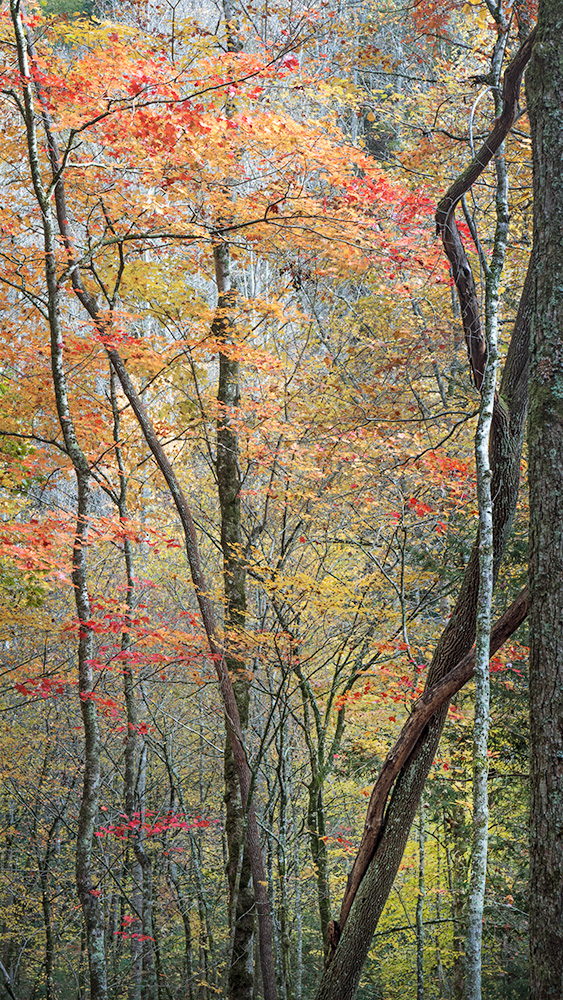
And this time, we decided the photo was done . . . unless I decide to make some more edits at a later date.
Here are the initial capture and final image side by side.

My hope is that the final image shares the beauty I saw in the woods last fall with you.
If you’d to learn more about how Bill and I approach editing our photos, join us for our Making Your Photos Look The Way You Want Them To Look Workshop on April 14. We’ll share more details about our editing workflow and help you develop an approach to editing your photos that works for you. You can read more about the workshop at https://beautifulflowerpictures.com/making-photos-look-way-want-look/
And if you have any questions about my approach to editing,leave a note in the comments below and I’ll try to answer them in a future newsletter.
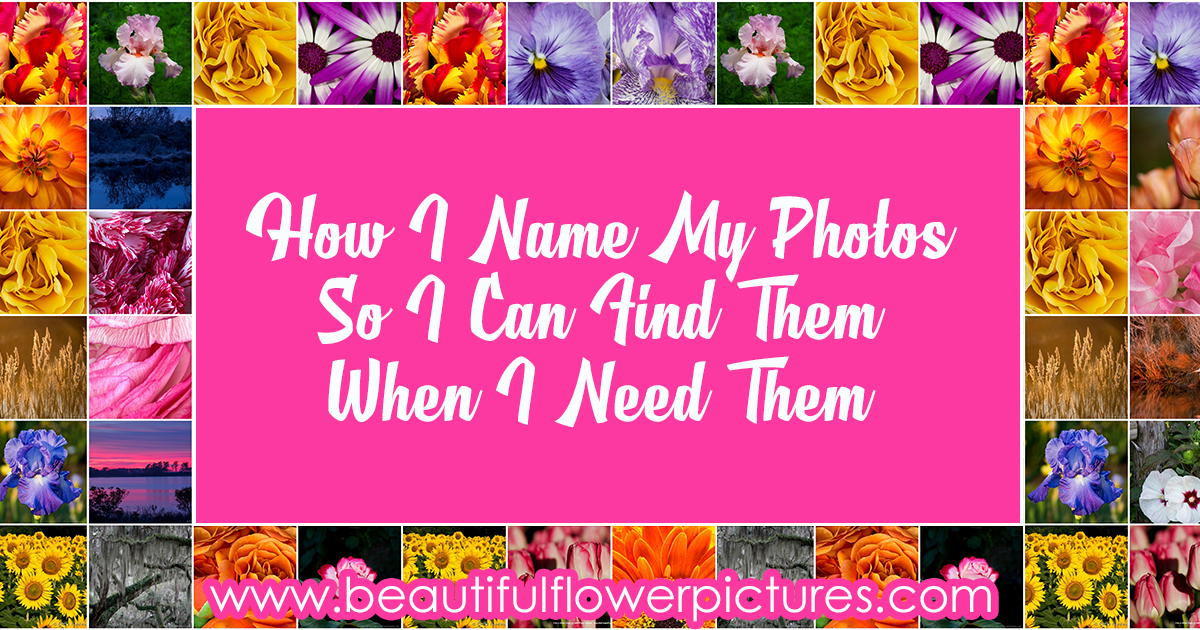
by hankinslawrenceimages | Nov 25, 2016 | Photo Tips, Software, Uncategorized
This is the third article in my series on how I organize my photo files so I can find the photos I want when I need them. In case you missed them, the first two articles in the series are How I Organize My Photo Files on my Computer and How I Organize My Photos in Lightroom.
I post a lot of photos on my blog – this year alone I’ve shared over 1000 photos (not to mention the over 5000 I’ve shared before this year) – which means I’ve had to come up with an awful lot of different names for my photos so I don’t accidentally give two the same name and not be able to tell them apart. I tried several naming conventions over the years and finally in mid-2012 I came up with one that works for me and I’ve continued to use it since then. I thought I’d share it with you today in case something similar might work for you.
The basic format for the file names is YYYY_MM_Description_####.jpg where
YYYY is the year I edited the photograph – so I know what date to put on the copyright notice.
MM is the month I edited the photograph.
Description is a few word description of the photo so I can search for it more quickly, and
is the four digit file number assigned to the original RAW file by my camera.
So the first file in the list of edited photos for this year is
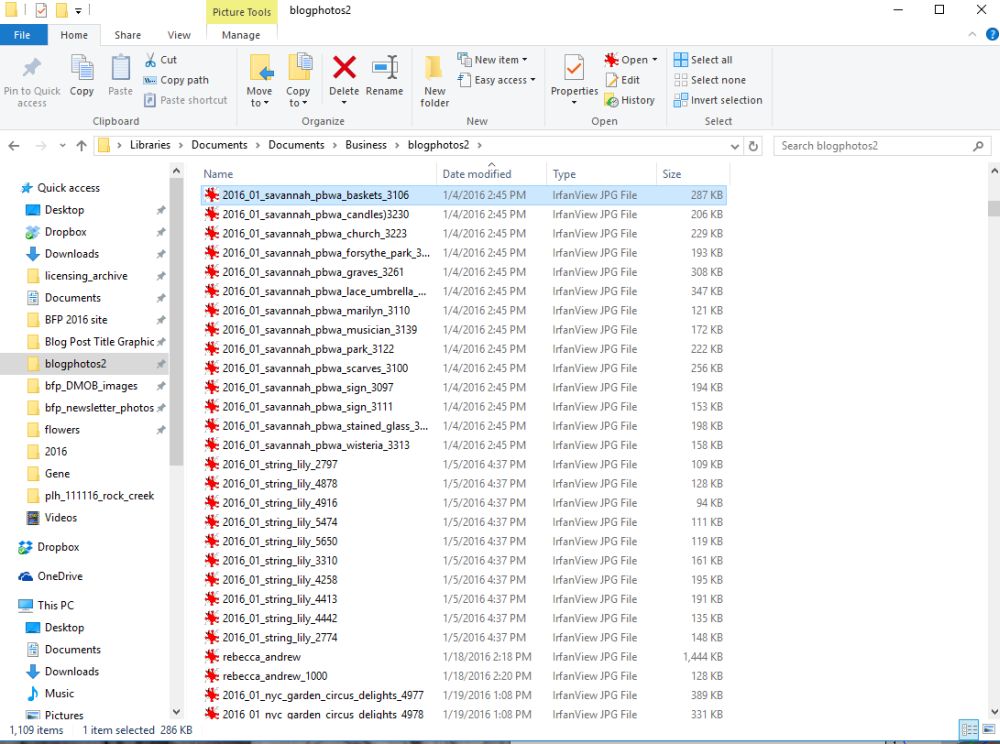
2016_01_savannah_pbwa_baskets_3106 – a photograph of baskets taken in Savannah, Ga that I edited on January 4, 2016
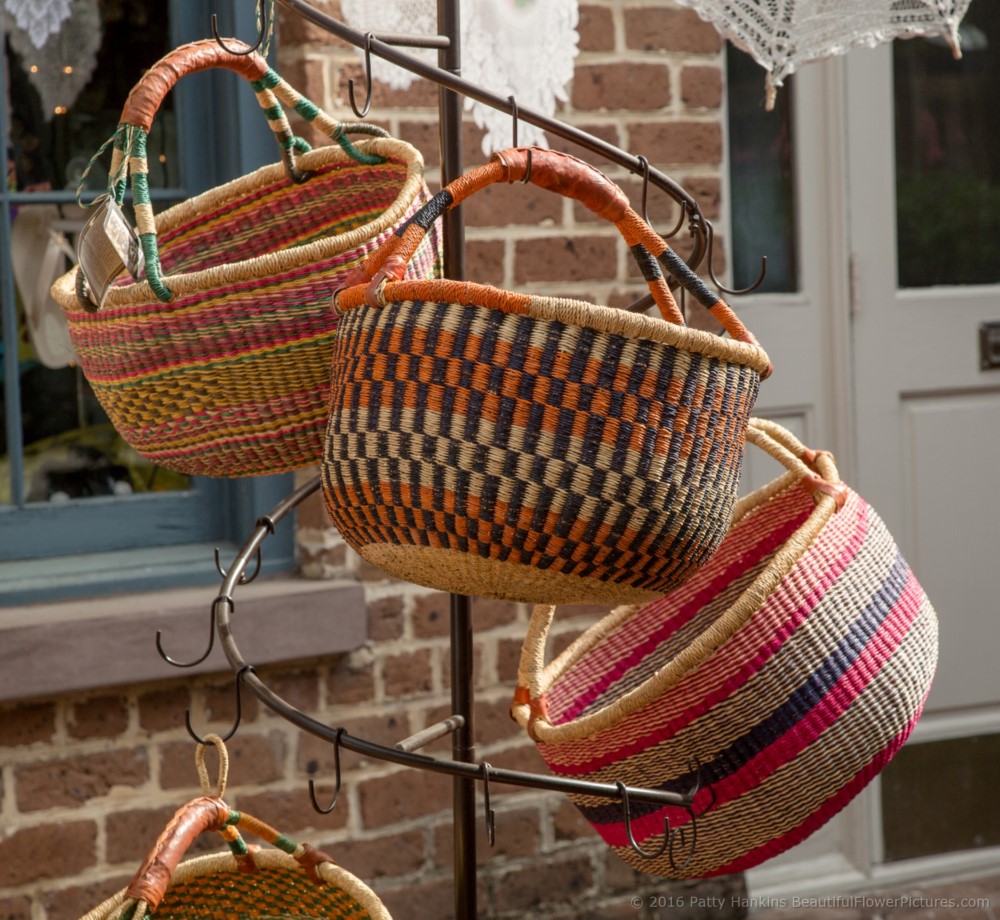
Baskets at Savannah’s City Market © 2016 Patty Hankins
And the most recent file is 2016_11_chrysanthemum_bill_holden_7485.jpg – a photo of a Bill Holden Chrysanthemum I took at Longwood Gardens on November 13.
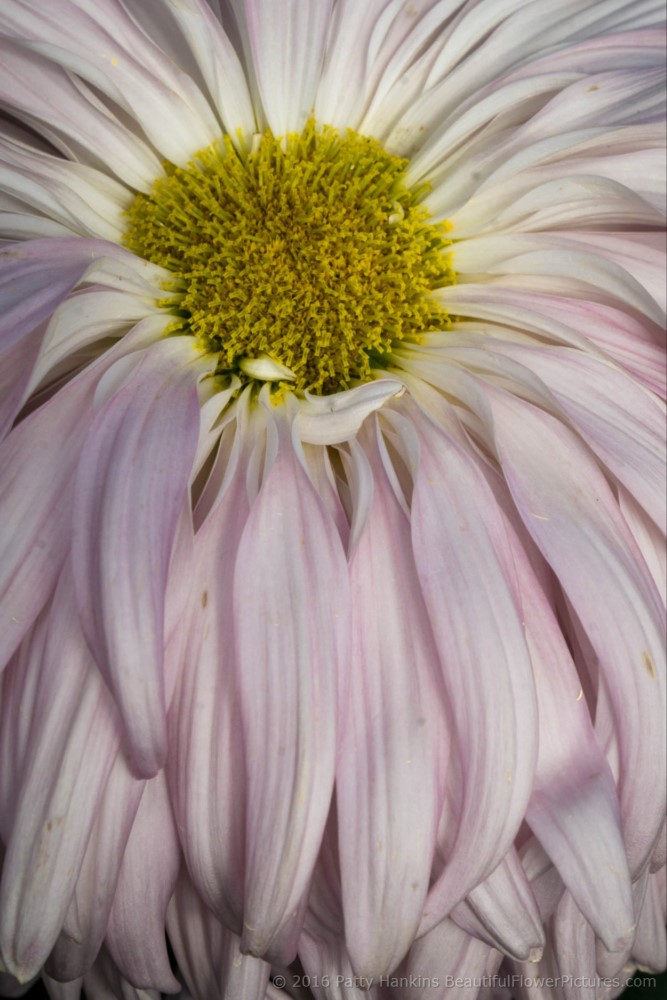
Bill Holden Chrysanthemum © 2016 Patty Hankins
The search functions in Windows 10 lets me easily find the edited photos on my computer.
As an example, let’s say I know I photographed a Bill Holden Chrysanthem but I can’t remember when I took the photo. All I have to do is go to the Blogphotos directory on my hard drive and search for Bill Holden. Once it pulls up all the photos with Bill Holden in the title, I just choose the one I want.
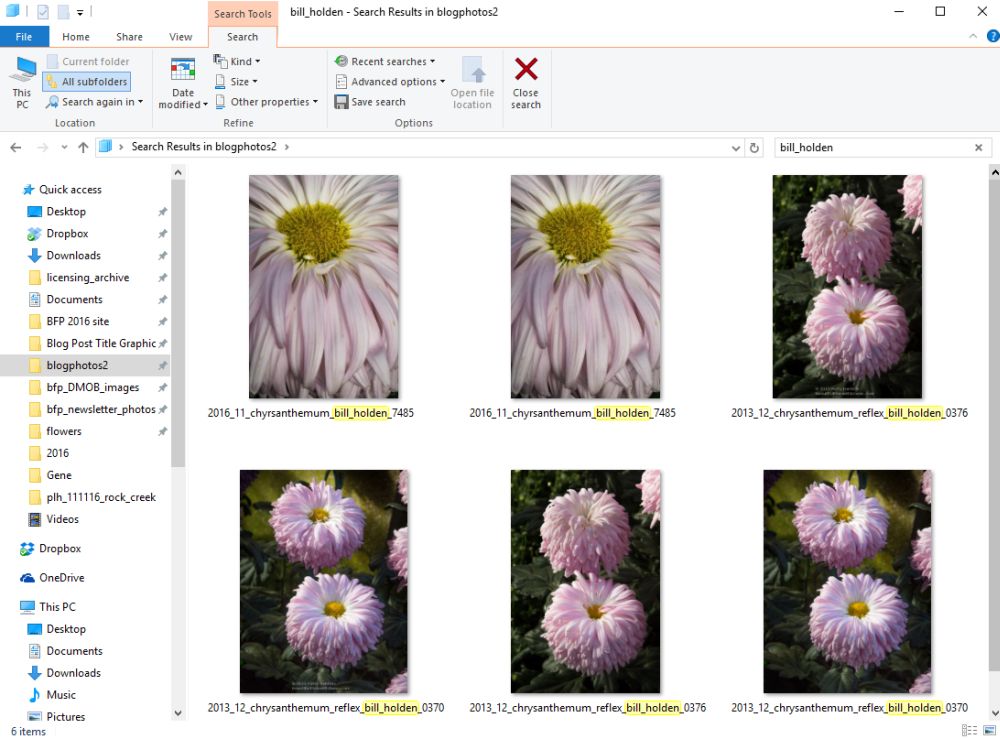
Windows Search for Bill Holden Chrysanthemum
Or if I know the last four digits of the file are 7485, I can search for all files with the code 7485.
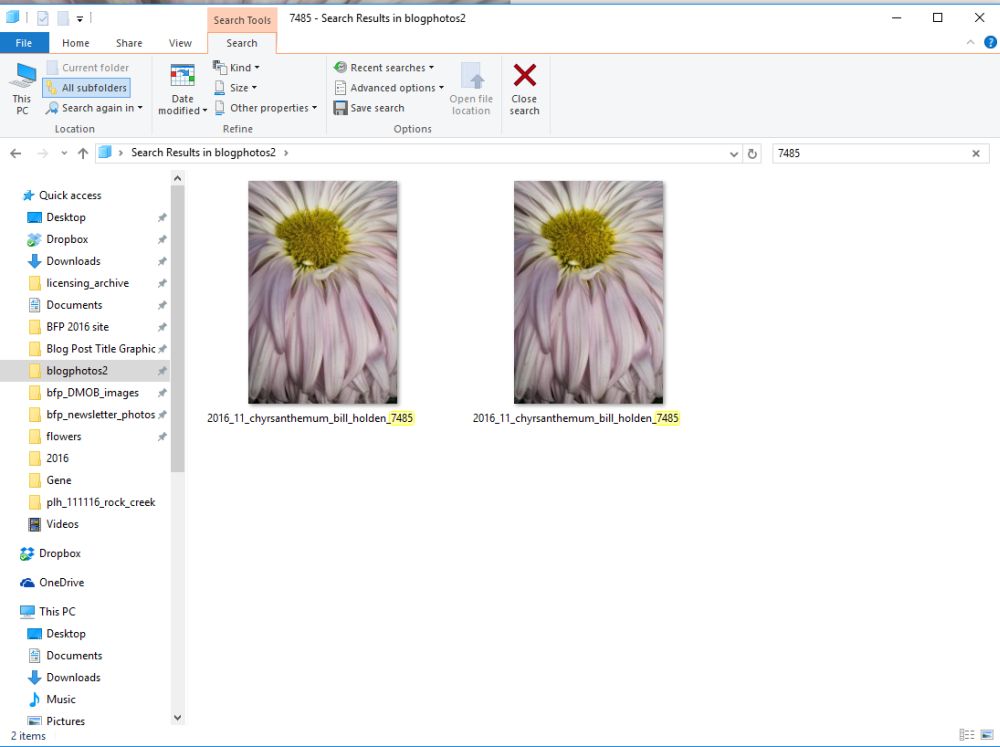
Windows Search for 7485
If I want to get back to the original image I can use the same information in the file name to access the my original RAW file in Lightroom.
Searching for 3106 brings up all the photos Bill or I have added to Lightroom with the file number 3106.
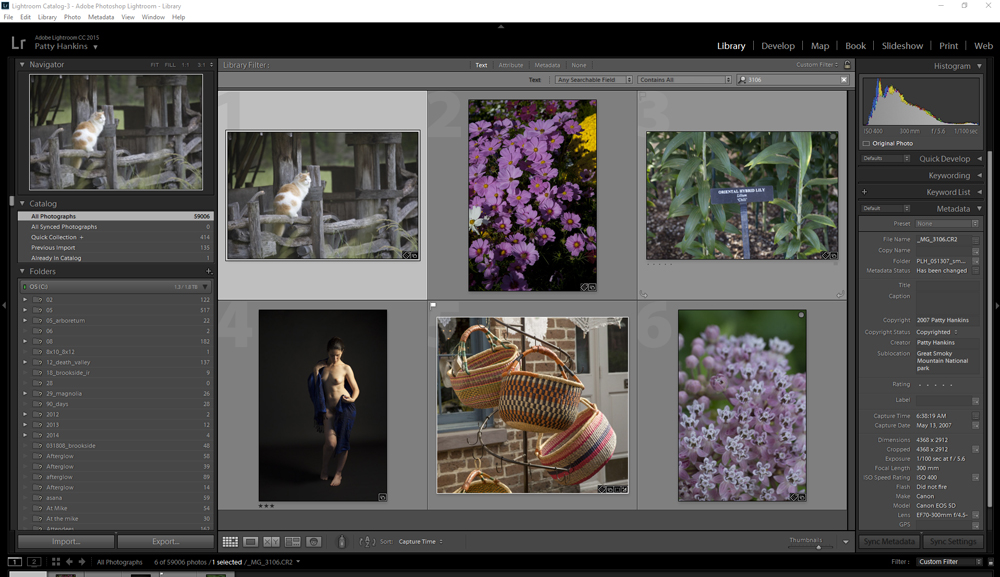
Files numbered 3106
Or I can search for photos with the keyword basket (and it turns out there is only one of those!)

Files with the keyword basket
I hope these this series of three articles make it easier for you to find your files on your computer. If yo have any questions about how I name my files, just let me know.


















































